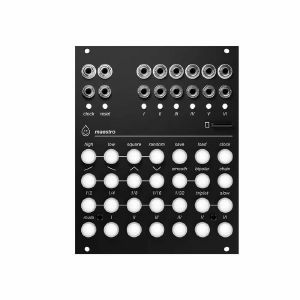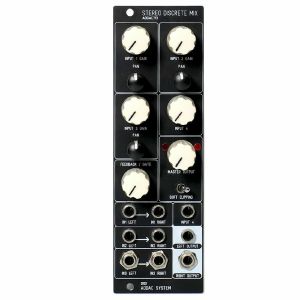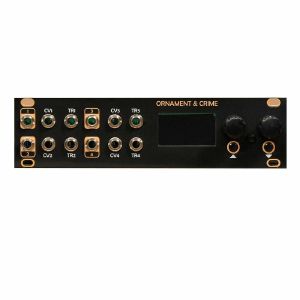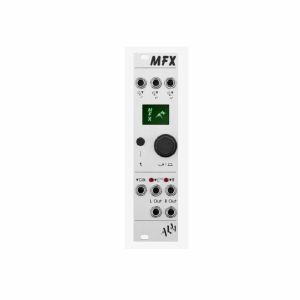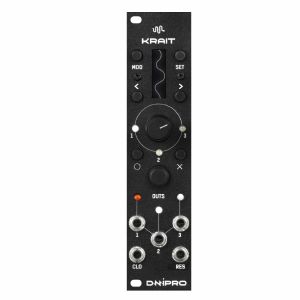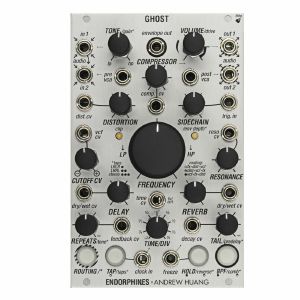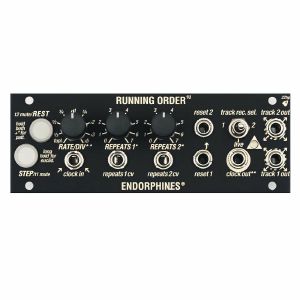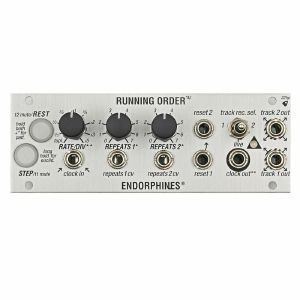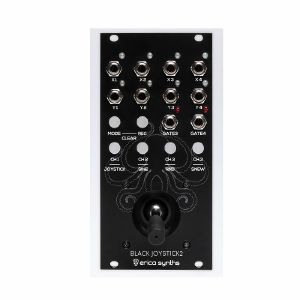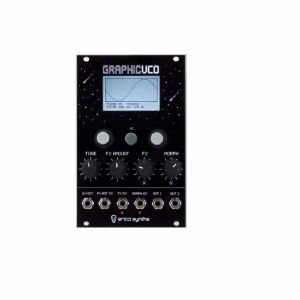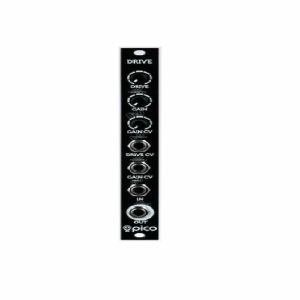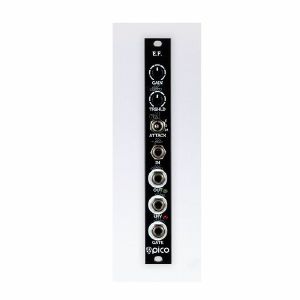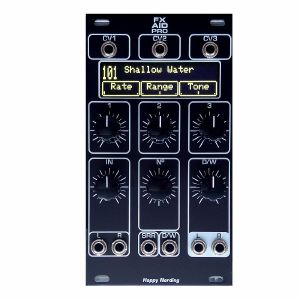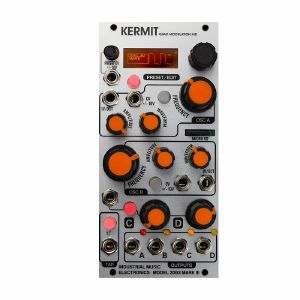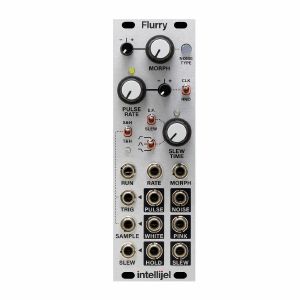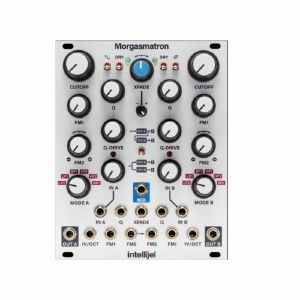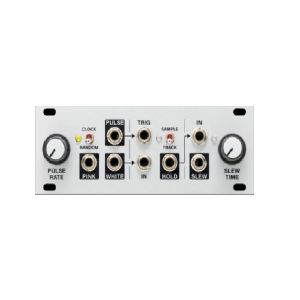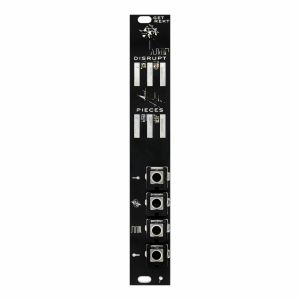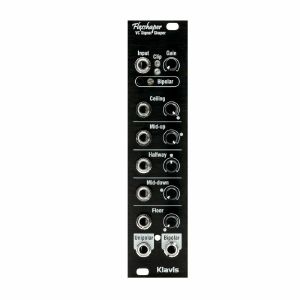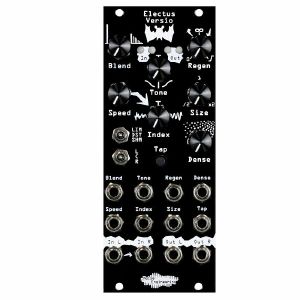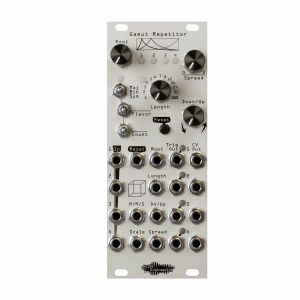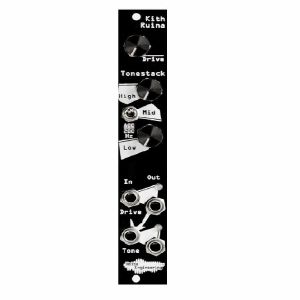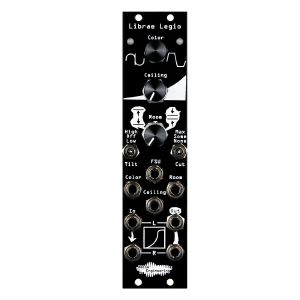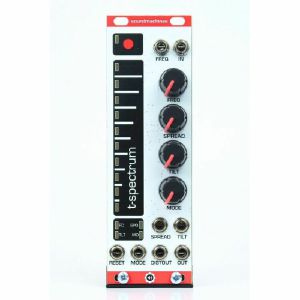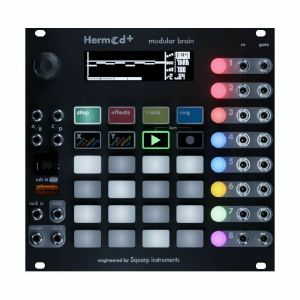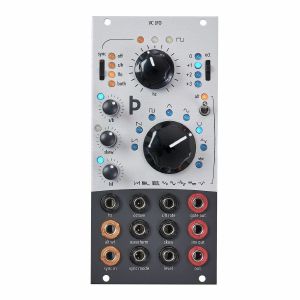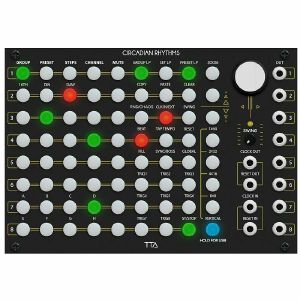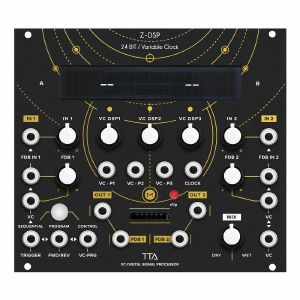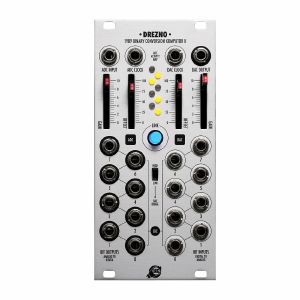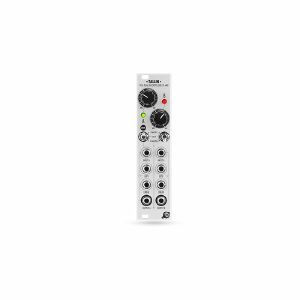Back catalogue: Studio Equipment
Juno's full catalogue of Studio EquipmentAcid Rain Technology Maestro 6-Channel Clocked Modulation Controller Module (clock generator/clock modulator/controller/CV modulation/envelope generator/LFO/random/sequencer module)
Cat: 804571 Rel: 22 Jan 21
6-channel clocked modulation module
Notes: Maestro is a 6 channel clocked modulation controller inspired by the automation lanes found in digital audio workstation software, brought into eurorack and made playable and performable. Maestro will push and pull the parameters of your other modules with rapid or slowly evolving voltages, always in perfect sync with eachother and the rest of your system.
Details:
20hp
25mm deep
65mA on +12, 18mA on -12, 0mA on 5V
… Read moreDetails:
20hp
25mm deep
65mA on +12, 18mA on -12, 0mA on 5V
1 in stock $399.37
Click for better price!
or call +44 20 7424 1960
quote 804571
quote 804571
ADDAC System ADDAC713 Stereo Discreet Mixer Module (distortion/dual/stereo/mixer/panning synth module)
Cat: 895315 Rel: 25 Jan 23
ADDAC713 stereo discrete mixer
Notes: Inspired by the legendary Moog CP3 mixer, the 713 tweaks the old-school discrete circuits into three stereo inputs and one mono channel, summing to stereo with adjustable feedback and clipping to add character.
Supplier's Notes:
ADDAC713 is the stereo version of ADDAC System's 703 Discrete Mixer.
Inspired by Moog's CP3 mixer, this is a fully discrete analogue mixer and it's not, by any means, your standard breakfast mixer, although it can behave like one.
This is a wolf in sheep's clothing. Despite its harmless looks there's a dark snarly soul behind that panel that wants to take your sounds into a realm of gritty gnarly growls.
This new version was initially thought of as a percussion mixer, with mono inputs and panning, to allow placing percussive voices in the stereo field, while keeping channel 4 in mono for low end sources like a kick drum or Bass. In the development process ADDAC System slightly changed this initial idea, adding stereo inputs for the first 3 channels, but still kept the 4th channel in mono.
All four [GAIN] controls go to extreme levels, the first 3channels also feature [PAN] controls. Feedback is used to overdrive the whole mix. As the control is turned clockwise the sound will be clipped harder until it goes completely off, this happens as feedback is increased the audio bias reference also moves up, at extreme levels it offsets the whole signal upwards until it completely goes above the top rail clipping the whole signal hence the resulting gate effect.
The [MASTER OUTPUT] sets the overall output gain of the mixer, the two leds monitor the audio output signal. The Soft clipping switch engages an anti-click circuit which adds a low pass before the output, the switch allows 3 states: Soft low pass / Off / Hard low pass.
Features:
Three channels with stereo inputs, gain and pan knob
One channel with mono input and gainknob
Feedback/gate knob
Master output volume knob
Soft clipping switch
Two Led Monitors for Left and Right channels
Tech Specs:
8HP
4cm deep
80mA +12V
80mA -12V
… Read moreSupplier's Notes:
ADDAC713 is the stereo version of ADDAC System's 703 Discrete Mixer.
Inspired by Moog's CP3 mixer, this is a fully discrete analogue mixer and it's not, by any means, your standard breakfast mixer, although it can behave like one.
This is a wolf in sheep's clothing. Despite its harmless looks there's a dark snarly soul behind that panel that wants to take your sounds into a realm of gritty gnarly growls.
This new version was initially thought of as a percussion mixer, with mono inputs and panning, to allow placing percussive voices in the stereo field, while keeping channel 4 in mono for low end sources like a kick drum or Bass. In the development process ADDAC System slightly changed this initial idea, adding stereo inputs for the first 3 channels, but still kept the 4th channel in mono.
All four [GAIN] controls go to extreme levels, the first 3channels also feature [PAN] controls. Feedback is used to overdrive the whole mix. As the control is turned clockwise the sound will be clipped harder until it goes completely off, this happens as feedback is increased the audio bias reference also moves up, at extreme levels it offsets the whole signal upwards until it completely goes above the top rail clipping the whole signal hence the resulting gate effect.
The [MASTER OUTPUT] sets the overall output gain of the mixer, the two leds monitor the audio output signal. The Soft clipping switch engages an anti-click circuit which adds a low pass before the output, the switch allows 3 states: Soft low pass / Off / Hard low pass.
Features:
Three channels with stereo inputs, gain and pan knob
One channel with mono input and gainknob
Feedback/gate knob
Master output volume knob
Soft clipping switch
Two Led Monitors for Left and Right channels
Tech Specs:
8HP
4cm deep
80mA +12V
80mA -12V
1 in stock $224.99
After Later Audio Alan Random Looping Sequencer Module (CV modulation/random/sequencer synth module)
Cat: 805272 Rel: 14 Jan 21
Register-based sequencer module
Notes: Alan (micro Turing Machine) Shift Register Based Sequencer
The randomness of the Music Thing Modular Turing Machine, shrunk down to 6HP. Alan retains all of the same functionality as the original including the connectors for the expanders.
While this module has little to do with the original Turing Machine (by Alan Turing), it is a shift register based sequencer. You cannot program this sequencer, instead it builds random sequences that can be locked in.
Alan comes tested, calibrated and ready to bring random voltages.
The After Later Audio panel is black and gold and made from FR4. The package will include a power/ribbon cable and a one year warranty.
… Read moreThe randomness of the Music Thing Modular Turing Machine, shrunk down to 6HP. Alan retains all of the same functionality as the original including the connectors for the expanders.
While this module has little to do with the original Turing Machine (by Alan Turing), it is a shift register based sequencer. You cannot program this sequencer, instead it builds random sequences that can be locked in.
Alan comes tested, calibrated and ready to bring random voltages.
The After Later Audio panel is black and gold and made from FR4. The package will include a power/ribbon cable and a one year warranty.
1 in stock $188.99
After Later Audio FFS For Fuzz Sake Two Fuzz Channels Module (modular synthesiser)
Cat: 1048740 Rel: 18 Oct 24
Two fuzz channels module - 10HP
Notes: Two fuzz channels based on the fuzz face circuit with a built-in pickup simulator.
Gnarly is a 7 knob beast that will destroy whatever you throw at it. It has many dead zones in the pots that will adjust based on the position of other pots. It's all about finding the sweet spots and living on those fine edges. The transistor pairs on this section are replaceable.
Oomph is a 5 knob bass friendly take on the fuzz face and compliments the upper harmonics of the Gnarly section.
Pickup simulator - Fuzz circuits offer unique sound when paired with the inductance of the pickup coils in a guitar. This why it is often suggested to have fuzz pedals as your first in a pedal chain. So After Later built-in a coil to simulate your eurorack signal being emitted by a guitar pickup. After Later also included a pickup simulator output so you can use it to interface with other fuzz instruments (pedals, modules, etc.).
As an added oddness - you can also input your guitar into the pickup sim output (just don't plug anything into the normal input). This will still get you Eurorack level output. Please don't input Eurorack levels into the pickup sim output.
Tips - Experiment with the pickup simulator and buffered signal. Use the PS.Level to keep the signal low, borderline on cutting out. You find lots of joy in the gnarly section by keeping this level at the edge.
Width: 10hp
12V: 15mA
-12V: 10mA
… Read moreGnarly is a 7 knob beast that will destroy whatever you throw at it. It has many dead zones in the pots that will adjust based on the position of other pots. It's all about finding the sweet spots and living on those fine edges. The transistor pairs on this section are replaceable.
Oomph is a 5 knob bass friendly take on the fuzz face and compliments the upper harmonics of the Gnarly section.
Pickup simulator - Fuzz circuits offer unique sound when paired with the inductance of the pickup coils in a guitar. This why it is often suggested to have fuzz pedals as your first in a pedal chain. So After Later built-in a coil to simulate your eurorack signal being emitted by a guitar pickup. After Later also included a pickup simulator output so you can use it to interface with other fuzz instruments (pedals, modules, etc.).
As an added oddness - you can also input your guitar into the pickup sim output (just don't plug anything into the normal input). This will still get you Eurorack level output. Please don't input Eurorack levels into the pickup sim output.
Tips - Experiment with the pickup simulator and buffered signal. Use the PS.Level to keep the signal low, borderline on cutting out. You find lots of joy in the gnarly section by keeping this level at the edge.
Width: 10hp
12V: 15mA
-12V: 10mA
1 in stock $103.49
Click for better price!
or call +44 20 7424 1960
quote 1048740
quote 1048740
After Later Audio uGrids Grids Redesigned Module (clock generator/digital/drum/random/sequencer synth module)
Cat: 910123 Rel: 21 Nov 22
An 8hp version of the retired Mutable Instruments Grids.
Notes: An 8hp version of the retired Mutable Instruments Grids. It is an identical functional clone, so it will behave in the same was as the full size version, and will run any firmware that runs on the full size version.
… Read more 1 in stock $166.50
Click for better price!
or call +44 20 7424 1960
quote 910123
quote 910123
After Later Audio uO_C 1U Micro Ornament & Crime Polymorphic CV Generator Module (CV modulation/envelope generator/LFO/MIDI/quad/quantizer/random/utility module)
Cat: 862179 Rel: 02 Feb 22
Polymorphic CV generator module - 30HP
Notes: Ornament & Crime for 1U Intellijel format
This is functionally identical to the 3U version, just re-oriented to fit in 1U racks. Ornament & Crime is designed by mxmxmx.
The apps currently available in Ornament & Crime:
CopierMaschine is an enhanced version of the original quantising digital emulation of a four stage analogue shift register (ASR).
Harrington 1200 provides basic neo-Riemannian Tonnetz transformations of triadic chords, triggered by the digital (gate/trigger) inputs.
Automatonnetz combines Tonnetz transforms with a "vector" sequencer - it can be both a chord sequencer and a melody sequencer, but not of the usual kind.
Quantermain is a quad pitch quantiser for external voltages, with editable scales; it can do clocked (trigger-driven) quantising, or continuous quantising, with a latency of under 100 microseconds; it also features quad Turing Machines, May-Verhulst logistic maps or byte beats as optional, semi-random, internally generated CV sources.
Meta-Q is a dual-channel quantiser, similar to Quantermain, but also offering scale and note mask sequencing.
Quadraturia is a wavetable quadrature LFO, based on the "Easter egg" in the Mutable Instruments Frames module.
Low-rents is a dual Lorenz and Rossler (strange attractor) modulation generator, partially based on the "Easter egg" in the Mutable Instruments Streams module.
Piqued is a quad voltage-controlled envelope generator, based on envelope generator code from the Mutable Instruments Peaks module, but extending it with voltage control, additional envelope types, including re-triggering (looping) envelopes, additional segment shapes, adjustable trigger delays, and a unique Euclidean "trigger filter" which turns the app into a Euclidean rhythm generator which can output envelopes, not just gate or trigger pulses.
Sequins is a dual-channel step sequencer offering 4 "tracks" of up to 16 steps each; tracks can themselves be sequenced.
Dialectic Ping Pong is a quad bouncing ball envelope generator, based on a hidden mode of the Mutable Instruments Peaks module.
Viznutcracker, sweet! is a quad "byte beat" equation generator, which can be used as an audio source to generate curious but often interesting 8-bit noises and tunes, or which can be clocked by an external source to produce "byte beat" control voltage sequences. "Byte beats" were first described in 2011 by viznut (aka Ville-Matias Heikkila).
Acid Curds is both a chord quantiser (sometimes called a "harmonic quantiser" for external pitch voltages), and a chord progression sequencer.
References is an utility app that outputs specific reference voltages on each channel to help tune or calibrate VCOs and other modules. It also includes a high-precision frequency meter and note tuner, a high-precision BPM (beats per minute) tempo meter, and a closed-loop calibration mode.
Width: 30hp
12V: 85mA
-12V: 10mA
… Read moreThis is functionally identical to the 3U version, just re-oriented to fit in 1U racks. Ornament & Crime is designed by mxmxmx.
The apps currently available in Ornament & Crime:
CopierMaschine is an enhanced version of the original quantising digital emulation of a four stage analogue shift register (ASR).
Harrington 1200 provides basic neo-Riemannian Tonnetz transformations of triadic chords, triggered by the digital (gate/trigger) inputs.
Automatonnetz combines Tonnetz transforms with a "vector" sequencer - it can be both a chord sequencer and a melody sequencer, but not of the usual kind.
Quantermain is a quad pitch quantiser for external voltages, with editable scales; it can do clocked (trigger-driven) quantising, or continuous quantising, with a latency of under 100 microseconds; it also features quad Turing Machines, May-Verhulst logistic maps or byte beats as optional, semi-random, internally generated CV sources.
Meta-Q is a dual-channel quantiser, similar to Quantermain, but also offering scale and note mask sequencing.
Quadraturia is a wavetable quadrature LFO, based on the "Easter egg" in the Mutable Instruments Frames module.
Low-rents is a dual Lorenz and Rossler (strange attractor) modulation generator, partially based on the "Easter egg" in the Mutable Instruments Streams module.
Piqued is a quad voltage-controlled envelope generator, based on envelope generator code from the Mutable Instruments Peaks module, but extending it with voltage control, additional envelope types, including re-triggering (looping) envelopes, additional segment shapes, adjustable trigger delays, and a unique Euclidean "trigger filter" which turns the app into a Euclidean rhythm generator which can output envelopes, not just gate or trigger pulses.
Sequins is a dual-channel step sequencer offering 4 "tracks" of up to 16 steps each; tracks can themselves be sequenced.
Dialectic Ping Pong is a quad bouncing ball envelope generator, based on a hidden mode of the Mutable Instruments Peaks module.
Viznutcracker, sweet! is a quad "byte beat" equation generator, which can be used as an audio source to generate curious but often interesting 8-bit noises and tunes, or which can be clocked by an external source to produce "byte beat" control voltage sequences. "Byte beats" were first described in 2011 by viznut (aka Ville-Matias Heikkila).
Acid Curds is both a chord quantiser (sometimes called a "harmonic quantiser" for external pitch voltages), and a chord progression sequencer.
References is an utility app that outputs specific reference voltages on each channel to help tune or calibrate VCOs and other modules. It also includes a high-precision frequency meter and note tuner, a high-precision BPM (beats per minute) tempo meter, and a closed-loop calibration mode.
Width: 30hp
12V: 85mA
-12V: 10mA
1 in stock $306.56
Click for better price!
or call +44 20 7424 1960
quote 862179
quote 862179
AJH Synth MiniMod Muting Mixer & VCA Audio Mixer Module (black) (mixer/VCA synth module)
Cat: 852985 Rel: 23 Feb 22
A dedicated audio mixer for the MiniMod range.
Notes: Five-channel mixer with mutes, built-in VCA, switchable overdrive and LED level meter. Simple, straightforward, high-quality stuff from AJH.
Supplier's Notes:
The MiniMod Muting Mixer & VCA is a 10HP wide, five channel audio mixer with many useful features. It is available with either a black (Dark Edition), or a silver front panel.
The mixer section has five input channels, and each channel includes a bi-colour tactile LED switch that can instantly mute or un-mute the channel, replicating the oscillator on/off switches on the original Model D synthesiser. This arrangement is more convenient than regular switches as each illuminated switch shows the on/off status of the associated channel and multiple buttons can be pressed at once, making it very useful for live performance.
AJH have also included a four segment LED level meter so that the overall level can be seen at a glance and adjusted to prevent the output from getting too "hot" and causing distortion in other modules further downstream.
It also features a VCA that is integrated into the output section, and this can be switched from linear to exponential response - this allows it to be used as a voltage controlled sub mixer or as a stand alone VCA with five inputs.
Lastly, AJH added a wonderfully soft and warm sounding overdrive circuit that can be switched in to add smooth, tube like distortion. This works in a similar fashion to a master volume guitar amplifier, so the amount of overdrive can be varied widely with different settings of channel and master output levels.
Module Width: 10hp
Module Depth: 26mm (Including power lead)
Current Usage: 55mA Positive, 25mA Negative
… Read moreSupplier's Notes:
The MiniMod Muting Mixer & VCA is a 10HP wide, five channel audio mixer with many useful features. It is available with either a black (Dark Edition), or a silver front panel.
The mixer section has five input channels, and each channel includes a bi-colour tactile LED switch that can instantly mute or un-mute the channel, replicating the oscillator on/off switches on the original Model D synthesiser. This arrangement is more convenient than regular switches as each illuminated switch shows the on/off status of the associated channel and multiple buttons can be pressed at once, making it very useful for live performance.
AJH have also included a four segment LED level meter so that the overall level can be seen at a glance and adjusted to prevent the output from getting too "hot" and causing distortion in other modules further downstream.
It also features a VCA that is integrated into the output section, and this can be switched from linear to exponential response - this allows it to be used as a voltage controlled sub mixer or as a stand alone VCA with five inputs.
Lastly, AJH added a wonderfully soft and warm sounding overdrive circuit that can be switched in to add smooth, tube like distortion. This works in a similar fashion to a master volume guitar amplifier, so the amount of overdrive can be varied widely with different settings of channel and master output levels.
Module Width: 10hp
Module Depth: 26mm (Including power lead)
Current Usage: 55mA Positive, 25mA Negative
1 in stock $257.62
Click for better price!
or call +44 20 7424 1960
quote 852985
quote 852985
ALM MFX Stereo Multi-Effects Processor Module (delay/digital/distortion/dual/stereo/dynamics/effect/tuner/utility synth module)
Cat: 867407 Rel: 04 Mar 22
The MFX is a compact 6HP Eurorack stereo digital audio multi effects processor.
Notes: The MFX is a compact 6HP Eurorack stereo digital audio multi effects processor.
It offers 14 different full featured effects programs plus a number of metering utilities.
Inspired by ALM's favourite classic hardware effects processors, the MFX incorporates DSP technologies from the dawn of digital effects in the 70s to the present day. This combines with ALM character and uniqueness to form a highly useful, fun and practical Eurorack effects module.
Reshape sounds with the distortion and dynamics engines. Bend time, space and pitch with multiple feature rich reverb and delay engines. Modulate signals with the flexible panner, frequency shifter, and range of ensemble effects. Fracture sounds with the one of a kind granular and glitch engines. Check signals and tune oscillators with various utilities.
The MFX user interface is designed to be familiar, quick and easy to use. Each program contains a wide range of controllable parameters both directly editable or freely assigned to CV or clocked control. Additionally, each program includes factory presets as well as the ability to store and recall user presets. All states are preserved across power cycles.
Effect Program List
Digi-PCM Echo
Feature rich digital delay taking inspiration from early prime time rack delay units with added modern features.
Tape-Tech Echo
Tape style delay with a digital pitch shifter bolted on.
Crumbular Echo
More experimental granular style echo.
Ursa Minor Echoverb
Emulation of the classic Ursa Major 'Space station' providing more delays and reverb type effects.
Pocket PL8 Reverb
Emulation of very early digital style reverbs with a dense metallic sound.
Almicon Reverb
Emulation of 80s studio style reverb great for bright rooms and vast synthetic spaces.
Quaidra Reverb
Emulation of a popular 90s rack reverb. Excels at creating airy, atmospheric reverbs.
TY-50 Compressor
Flexible modern compressor great for adding punch, smoothing transients or as a clean mix bus compressor.
Transient Shaper
Fast acting dynamics processor for reshaping the attack and release envelope of any sound.
TH-30 Distortion
A versatile distortion program with distortion types ranging from analog style saturation to intense digital wavefolding.
2051 Bit Corrupter
Real-time audio buffer designed to imitate malfunctioning digital audio equipment.
Modulating Panner
Clock-syncable mono or stereo auto-pan with an additional scan mode that cross fades between 2 input signals. Use for VCA, Panner, crossfader, tremolo type effects.
Ring + Freq Modulator
Pair of classic modulation effects in stereo, tailored towards otherworldly and dissonant sounds.
Ensembles Ensemble
Simulation of classic chorus and ensemble effects. An added digital pitch shifter takes the effect beyond traditional chorus circuits.
Utilities
Simple oscilloscope and VCO tuner.
Technical Specifications
Supply: +12V 50mA Max / -12v 15mA
Size: 6 HP
Depth: 32mm
16 Bit / 44.1Khz Stereo processing
… Read moreIt offers 14 different full featured effects programs plus a number of metering utilities.
Inspired by ALM's favourite classic hardware effects processors, the MFX incorporates DSP technologies from the dawn of digital effects in the 70s to the present day. This combines with ALM character and uniqueness to form a highly useful, fun and practical Eurorack effects module.
Reshape sounds with the distortion and dynamics engines. Bend time, space and pitch with multiple feature rich reverb and delay engines. Modulate signals with the flexible panner, frequency shifter, and range of ensemble effects. Fracture sounds with the one of a kind granular and glitch engines. Check signals and tune oscillators with various utilities.
The MFX user interface is designed to be familiar, quick and easy to use. Each program contains a wide range of controllable parameters both directly editable or freely assigned to CV or clocked control. Additionally, each program includes factory presets as well as the ability to store and recall user presets. All states are preserved across power cycles.
Effect Program List
Digi-PCM Echo
Feature rich digital delay taking inspiration from early prime time rack delay units with added modern features.
Tape-Tech Echo
Tape style delay with a digital pitch shifter bolted on.
Crumbular Echo
More experimental granular style echo.
Ursa Minor Echoverb
Emulation of the classic Ursa Major 'Space station' providing more delays and reverb type effects.
Pocket PL8 Reverb
Emulation of very early digital style reverbs with a dense metallic sound.
Almicon Reverb
Emulation of 80s studio style reverb great for bright rooms and vast synthetic spaces.
Quaidra Reverb
Emulation of a popular 90s rack reverb. Excels at creating airy, atmospheric reverbs.
TY-50 Compressor
Flexible modern compressor great for adding punch, smoothing transients or as a clean mix bus compressor.
Transient Shaper
Fast acting dynamics processor for reshaping the attack and release envelope of any sound.
TH-30 Distortion
A versatile distortion program with distortion types ranging from analog style saturation to intense digital wavefolding.
2051 Bit Corrupter
Real-time audio buffer designed to imitate malfunctioning digital audio equipment.
Modulating Panner
Clock-syncable mono or stereo auto-pan with an additional scan mode that cross fades between 2 input signals. Use for VCA, Panner, crossfader, tremolo type effects.
Ring + Freq Modulator
Pair of classic modulation effects in stereo, tailored towards otherworldly and dissonant sounds.
Ensembles Ensemble
Simulation of classic chorus and ensemble effects. An added digital pitch shifter takes the effect beyond traditional chorus circuits.
Utilities
Simple oscilloscope and VCO tuner.
Technical Specifications
Supply: +12V 50mA Max / -12v 15mA
Size: 6 HP
Depth: 32mm
16 Bit / 44.1Khz Stereo processing
1 in stock $267.75
Befaco FX Boy GameBoy Cartridge-Based Multi-Effects Module (effect/distortion/filter/fuzz/waveshaper synth module)
Cat: 946023 Rel: 19 Oct 23
A GameBoy cartridge-based effects unit module in 12HP.
Notes: Befaco's unique GameBoy-based effects module allows you to change effects by swapping cartridges, all with CV control over key parameters. Effects include Skuara's harsh fuzz, Instruo's micro phaser and much more.
Supplier's Notes:
A crazy idea with the support of a bunch of crazy people.
A Multi FX module based on game carts!
FxBoy is a multi-FX module designed in collaboration with several talented manufacturers.
This is an effect unit with CV control over the parameters and Dry/wet control, with a Built-in CV controllable four bands EQ.
Each effect is physically hosted in a hot-swappable game cart and designed by a different manufacturer: Touell Skouarn with Skuara a harsh fuzz with overdrive, Instruo with micro Phaser, a two-flavoured Phaser, Feedback modules with a vintage Flanger, XOR with FX-Girl, a digital double effect module: Delay + Granularizer, Making sound machines with an analogue Wave folder, Tesseract with a bit crusher and Befaco Trash distortion!
What have these crazy people put in their cartridges?
Trash
Trash is a harmonic distortion that combines both clipping and folding flavours. Modes A and B will select between aggressive and more aggressive flavours!
Flanger
Analogue Wavefolder
Eskuara
AVMA
AVMA by Tesseract Modular is a bipolar VCA with one switchable wavefolder stage followed by an analogue frequency reducer. The VCA gain is x2, it can be used with i5V oscillator signals at the CV input for ring modulation effect.
Micro Phaser
Three cascaded all-pass filters, a built-in LFO and a saturator in the feedback path.
The purpose for this cartridge is to completely f&%k your phase up!
Instruo - We make sounds with the things that we make to make sounds with.
Technical Specifications
CV control over all parameters and Dry/wet
CV controllable four-band EQ, routable post or pre-effect.
Hot swap for all carts.
Selector for two different flavours of each cart.
Open specifications to design your own carts
Specs
Current needs: +12V: 125mA, -12V: 100mA, 5v: 0mA
Width: 12 HP
Depth: 35 mm (including power connector)
Aluminium, heat-treated front panel.
Designed and assembled in Barcelona.
… Read moreSupplier's Notes:
A crazy idea with the support of a bunch of crazy people.
A Multi FX module based on game carts!
FxBoy is a multi-FX module designed in collaboration with several talented manufacturers.
This is an effect unit with CV control over the parameters and Dry/wet control, with a Built-in CV controllable four bands EQ.
Each effect is physically hosted in a hot-swappable game cart and designed by a different manufacturer: Touell Skouarn with Skuara a harsh fuzz with overdrive, Instruo with micro Phaser, a two-flavoured Phaser, Feedback modules with a vintage Flanger, XOR with FX-Girl, a digital double effect module: Delay + Granularizer, Making sound machines with an analogue Wave folder, Tesseract with a bit crusher and Befaco Trash distortion!
What have these crazy people put in their cartridges?
Trash
Trash is a harmonic distortion that combines both clipping and folding flavours. Modes A and B will select between aggressive and more aggressive flavours!
Flanger
Analogue Wavefolder
Eskuara
AVMA
AVMA by Tesseract Modular is a bipolar VCA with one switchable wavefolder stage followed by an analogue frequency reducer. The VCA gain is x2, it can be used with i5V oscillator signals at the CV input for ring modulation effect.
Micro Phaser
Three cascaded all-pass filters, a built-in LFO and a saturator in the feedback path.
The purpose for this cartridge is to completely f&%k your phase up!
Instruo - We make sounds with the things that we make to make sounds with.
Technical Specifications
CV control over all parameters and Dry/wet
CV controllable four-band EQ, routable post or pre-effect.
Hot swap for all carts.
Selector for two different flavours of each cart.
Open specifications to design your own carts
Specs
Current needs: +12V: 125mA, -12V: 100mA, 5v: 0mA
Width: 12 HP
Depth: 35 mm (including power connector)
Aluminium, heat-treated front panel.
Designed and assembled in Barcelona.
1 in stock $431.99
Click for better price!
or call +44 20 7424 1960
quote 946023
quote 946023
Dnipro Krait 3-Channel Knob Recorder/LFO/Random Generator Module (controller/LFO/random synth module)
Cat: 846610 Rel: 01 Nov 21
A 3-channel knob recorder, LFO & random generator.
Notes: Dnipro serve up a solid option for generating modulation signals: knob recording, LFOs or loopable random modulation, all syncable to a clock signal. Nice touches include tap tempo and slew.
Supplier's Notes:
Krait is flexible 3-channel modulation source for eurorack system. Each channel can be either a Knob Recorder, LFO or loopable Random Generator.
The module is designed to be in solid sync with your beats, so in order to work, Krait should receive steady external clock pulse. However, LFO will work without clock. All settings and waveforms will be autosaved and reloaded after power off.
Knob Recorder:
Can record pot turns, up to 8 bars loops possible.
LFO:
Tap tempo LFO with morphable waveforms and phase offset. Sync it to your beats.
Random Generator:
Syncable random with portamento and possibility to freeze and loop 16 steps.
Technical details:
6 HP
70 mA +12V
12mA -12V
0 mA 5V
42 mm deep
Voltage ranges: +5-5v, 0v+5v
… Read moreSupplier's Notes:
Krait is flexible 3-channel modulation source for eurorack system. Each channel can be either a Knob Recorder, LFO or loopable Random Generator.
The module is designed to be in solid sync with your beats, so in order to work, Krait should receive steady external clock pulse. However, LFO will work without clock. All settings and waveforms will be autosaved and reloaded after power off.
Knob Recorder:
Can record pot turns, up to 8 bars loops possible.
LFO:
Tap tempo LFO with morphable waveforms and phase offset. Sync it to your beats.
Random Generator:
Syncable random with portamento and possibility to freeze and loop 16 steps.
Technical details:
6 HP
70 mA +12V
12mA -12V
0 mA 5V
42 mm deep
Voltage ranges: +5-5v, 0v+5v
1 in stock $293.61
Click for better price!
or call +44 20 7424 1960
quote 846610
quote 846610
Endorphin.es Ghost Audio Processor Module (silver) (delay/digital/distortion/dual/stereo/dynamics/effect/filter/reverb synth module)
Cat: 880294 Rel: 05 Oct 22
In collaboration with ANDREW HUANG, based on his modern music production techniques ENDORPHIN.ES developed a creative audio processor with multiple blocks that can be moved around in order to achieve different flavors for sound design.
Notes: Collabing with YouTube sensation Andrew Huang, Endorphin.es offer up this impressive multipurpose processor module. Building blocks of stereo filtering, compression, reverb and more offer huge creative potential.
Supplier's Notes:
In collaboration with Andrew Huang, based on his modern music production techniques, Endorphin.es developed a creative audio processor with multiple blocks that can be moved around in order to achieve different flavours for sound design.
Processing unit without fixed structure: intuitively create astonishing and ephemeral timbres, from atmospheric rumbles to heavy or distorted textures.
Creative stereo effect processor with delay, reverb, filter and distortion with quickly explorable routing chain with single button press.
New generation ARM Cortex - M7 processor with 96 kHz 32 bit internal processing.
Lush hall and whooshing reverse reverbs with audio freeze and pre-delay.
Sidechain audio ducking envelope available both internally and externally with additional one knob single band compressor.
Tap delay with maximum delay time up to 2.5 seconds, external clock input with onboard clock divider and 1v/oct time control.
8x oversampled distortion algorithm.
Pre- and post - VCA, tone and volume controls with extra gain.
Power consumption
135 mA +12V
35 mA -12V
0 mA 5V
Dimensions
16 HP
26 mm deep with power ribbon cable connected.
… Read moreSupplier's Notes:
In collaboration with Andrew Huang, based on his modern music production techniques, Endorphin.es developed a creative audio processor with multiple blocks that can be moved around in order to achieve different flavours for sound design.
Processing unit without fixed structure: intuitively create astonishing and ephemeral timbres, from atmospheric rumbles to heavy or distorted textures.
Creative stereo effect processor with delay, reverb, filter and distortion with quickly explorable routing chain with single button press.
New generation ARM Cortex - M7 processor with 96 kHz 32 bit internal processing.
Lush hall and whooshing reverse reverbs with audio freeze and pre-delay.
Sidechain audio ducking envelope available both internally and externally with additional one knob single band compressor.
Tap delay with maximum delay time up to 2.5 seconds, external clock input with onboard clock divider and 1v/oct time control.
8x oversampled distortion algorithm.
Pre- and post - VCA, tone and volume controls with extra gain.
Power consumption
135 mA +12V
35 mA -12V
0 mA 5V
Dimensions
16 HP
26 mm deep with power ribbon cable connected.
2 in stock $371.24
Click for better price!
or call +44 20 7424 1960
quote 880294
quote 880294
Endorphin.es Running Order 1U 2-Track Trigger Sequencer/Euclidean Generator Module (black) (sequencer synth module)
Cat: 880299 Rel: 02 Dec 22
2-track trigger sequencer/euclidean generator module - 22HP
Notes: Running Order is a two track trigger sequencer. It can be a precise master clock or manipulate incoming clock signal and works great in use as a sub-sequencer/divider in your Eurorack environment.
Zero-jitter clock generation: less than 50 microseconds internal clock jitter
101 style 1/16th note input mode (step/rest) with manual or CV controllable amount of triggers repeats when the active trigger step happens
Euclidean mode enabled for each track where we set Euclidean total steps amount in the circle and then amount of triggers happening in that circle.
Per step trigger probability in 101 mode and global probability in Euclidean mode.
Separate synchronization (reset) inputs, sync for track 1 is normalled to sync track 2
Clock divider for incoming external clock allows to quickly obtain various musical divisions on the fly incl. triplets of course, but more importantly tuplets mode allows you to stretch desired amount of triggers happening into a single bar
Separate mute buttons for each track
8 patterns of triggers sequences stored in the module and recalled on the next power up
Available in 3U / 6HP version
Power consumption:
30 mA +12V
10 mA -12V
0 mA 5V
Dimensions
22 HP
26mm deep with power ribbon cable connected
… Read moreZero-jitter clock generation: less than 50 microseconds internal clock jitter
101 style 1/16th note input mode (step/rest) with manual or CV controllable amount of triggers repeats when the active trigger step happens
Euclidean mode enabled for each track where we set Euclidean total steps amount in the circle and then amount of triggers happening in that circle.
Per step trigger probability in 101 mode and global probability in Euclidean mode.
Separate synchronization (reset) inputs, sync for track 1 is normalled to sync track 2
Clock divider for incoming external clock allows to quickly obtain various musical divisions on the fly incl. triplets of course, but more importantly tuplets mode allows you to stretch desired amount of triggers happening into a single bar
Separate mute buttons for each track
8 patterns of triggers sequences stored in the module and recalled on the next power up
Available in 3U / 6HP version
Power consumption:
30 mA +12V
10 mA -12V
0 mA 5V
Dimensions
22 HP
26mm deep with power ribbon cable connected
1 in stock $140.62
Click for better price!
or call +44 20 7424 1960
quote 880299
quote 880299
Endorphin.es Running Order 1U 2-Track Trigger Sequencer/Euclidean Generator Module (silver) (clock generator/clock modulator/random/sequencer synth module)
Cat: 880295 Rel: 02 Dec 22
2-track trigger sequencer/euclidean generator module - 22HP
Notes: Running Order is a two track trigger sequencer. It can be a precise master clock or manipulate incoming clock signal and works great in use as a sub-sequencer/divider in your Eurorack environment.
Zero-jitter clock generation: less than 50 microseconds internal clock jitter
101 style 1/16th note input mode (step/rest) with manual or CV controllable amount of triggers repeats when the active trigger step happens
Euclidean mode enabled for each track where we set Euclidean total steps amount in the circle and then amount of triggers happening in that circle.
Per step trigger probability in 101 mode and global probability in Euclidean mode.
Separate synchronization (reset) inputs, sync for track 1 is normalled to sync track 2
Clock divider for incoming external clock allows to quickly obtain various musical divisions on the fly incl. triplets of course, but more importantly tuplets mode allows you to stretch desired amount of triggers happening into a single bar
Separate mute buttons for each track
8 patterns of triggers sequences stored in the module and recalled on the next power up
Available in 3U / 6HP version
Power consumption:
30 mA +12V
10 mA -12V
0 mA 5V
Dimensions:
22 HP
26mm deep with power ribbon cable connected
… Read moreZero-jitter clock generation: less than 50 microseconds internal clock jitter
101 style 1/16th note input mode (step/rest) with manual or CV controllable amount of triggers repeats when the active trigger step happens
Euclidean mode enabled for each track where we set Euclidean total steps amount in the circle and then amount of triggers happening in that circle.
Per step trigger probability in 101 mode and global probability in Euclidean mode.
Separate synchronization (reset) inputs, sync for track 1 is normalled to sync track 2
Clock divider for incoming external clock allows to quickly obtain various musical divisions on the fly incl. triplets of course, but more importantly tuplets mode allows you to stretch desired amount of triggers happening into a single bar
Separate mute buttons for each track
8 patterns of triggers sequences stored in the module and recalled on the next power up
Available in 3U / 6HP version
Power consumption:
30 mA +12V
10 mA -12V
0 mA 5V
Dimensions:
22 HP
26mm deep with power ribbon cable connected
1 in stock $140.62
Click for better price!
or call +44 20 7424 1960
quote 880295
quote 880295
Erica Synths Black Joystick2 4-Channel Recordable Joystick Controller Module (controller synth module)
Cat: 812600 Rel: 23 Feb 21
8-channel multi-functional CV source, joystick, movement recorder & distinct LFO module - 12HP
Notes: Multi-function eight-channel LFO, joystick, movement recorder and drone oscillator that packs in lots more functionality than you might expect. A real modulation powerhouse in a compact format.
Supplier's Notes:
Erica Synths Black Joystick2 is 8 channel multi functional CV and sound source - joystick, movement recorder, distinct LFO and drone/noise oscillator. It provides great interaction with the modular system and allows to develop unconventional modulation patterns instantly.
… Read moreSupplier's Notes:
Erica Synths Black Joystick2 is 8 channel multi functional CV and sound source - joystick, movement recorder, distinct LFO and drone/noise oscillator. It provides great interaction with the modular system and allows to develop unconventional modulation patterns instantly.
1 in stock $234.00
Erica Synths Graphic VCO Advanced Wavetable VCO Module (oscillator synth module)
Cat: 771733 Rel: 06 Apr 20
Advanced wavetable VCO module with wave & FX design features - 16HP
Notes: Better known for analogue modules, it turns out Erica Synths are pretty damn good at digital too. Draw your own waveforms, build wavetables, tweak in real time and get freaky. Killer VCO.
Supplier's notes:
Erica Synths Graphic VCO allows you to draw your own waveforms, arrange them in wavetables and wavetable banks, morph between two selected waves and alter the resulting wave in advanced ways (FXes) - apply FM, phase distortion, ring modulation, wavefold/wavewrap, bitcrush.
Waves, wavetables, FXes and other settings can be saved and recalled from the memory instantly. The module has two outputs - the main output and the output with configurable suboscillator.
NB! To have the module functionality up to date, we recommend you to check the Erica Synths home pageor our social media from time to timefor announcements about firmware updates for the Graphic VCO. You can update the firmware of the module via miniUSB cable. More detailed instructions of the firmware update can be found in the User Manual.
The sound is clean, modern, punchy and detailed thanks to the unit running at 96kHz - quite different to some low bit-rate wavetable oscillators on the market. Wavetable interpolation is smooth as butter and with the built-in effects you can dirty things up in many different ways. The module scores highly on the sound front. The Graphic VCO is a very capable oscillator module with excellent sound quality and a lot of features that could make it the right choice, especially if live performance is your thing. - Sound On Sound
The bottom line is that the Graphic VCO is a joy to use. It's a module that's unashamedly digital, yet unmistakably eurorack. I think Erica showed a great deal of careful judgement and restraint in the design of this module. It would have been easy to have made it bloated and cumbersome trying to cram as many features as possible into it, but they kept it fairly simple which keeps the module fun and immediate in use. It's capable of a huge tonal palette ranging from beautiful to brutal that is bound to fit in with a lot of different styles and systems. - Ask Audio
The ability to draw and then effortlessly jump between different custom digital waveforms in this way feels unique on the Eurorack stage, and allows for a wide range of tones and transitions between them. - Orb Mag
Technical specifications:
Audio output amplitude
10Vptp
Octave range
C0-C8
Sample rate
96kHz
Unipolar CV input range
0 -+10V
Bipolar CV input range
-10V -+10V
Panel Width
16 HP
Module depth
30mm
Power consumption
152mA@+12V,
20mA@-12V
… Read moreSupplier's notes:
Erica Synths Graphic VCO allows you to draw your own waveforms, arrange them in wavetables and wavetable banks, morph between two selected waves and alter the resulting wave in advanced ways (FXes) - apply FM, phase distortion, ring modulation, wavefold/wavewrap, bitcrush.
Waves, wavetables, FXes and other settings can be saved and recalled from the memory instantly. The module has two outputs - the main output and the output with configurable suboscillator.
NB! To have the module functionality up to date, we recommend you to check the Erica Synths home pageor our social media from time to timefor announcements about firmware updates for the Graphic VCO. You can update the firmware of the module via miniUSB cable. More detailed instructions of the firmware update can be found in the User Manual.
The sound is clean, modern, punchy and detailed thanks to the unit running at 96kHz - quite different to some low bit-rate wavetable oscillators on the market. Wavetable interpolation is smooth as butter and with the built-in effects you can dirty things up in many different ways. The module scores highly on the sound front. The Graphic VCO is a very capable oscillator module with excellent sound quality and a lot of features that could make it the right choice, especially if live performance is your thing. - Sound On Sound
The bottom line is that the Graphic VCO is a joy to use. It's a module that's unashamedly digital, yet unmistakably eurorack. I think Erica showed a great deal of careful judgement and restraint in the design of this module. It would have been easy to have made it bloated and cumbersome trying to cram as many features as possible into it, but they kept it fairly simple which keeps the module fun and immediate in use. It's capable of a huge tonal palette ranging from beautiful to brutal that is bound to fit in with a lot of different styles and systems. - Ask Audio
The ability to draw and then effortlessly jump between different custom digital waveforms in this way feels unique on the Eurorack stage, and allows for a wide range of tones and transitions between them. - Orb Mag
Technical specifications:
Audio output amplitude
10Vptp
Octave range
C0-C8
Sample rate
96kHz
Unipolar CV input range
0 -+10V
Bipolar CV input range
-10V -+10V
Panel Width
16 HP
Module depth
30mm
Power consumption
152mA@+12V,
20mA@-12V
1 in stock $288.00
Click for better price!
or call +44 20 7424 1960
quote 771733
quote 771733
Erica Synths Pico Drive Wavefolder-Overdrive Module (distortion/effect/waveshaper module)
Cat: 773240 Rel: 23 Apr 20
Wavefolder & overdrive module - 3HP
Notes: Want some distorted drums or thicken up the final mix but you are short in rack space? Pico Drive is the answer! Pico Drive is combined wavefolder overdrive module that features manually adjustable Gain and Drive level, CV control over Gain and Drive adds more expression, while built in limiter prevents output signal to run into undesired clipping.
Features:
Manual Gain and Drive controls
CV control over Gain and Drive
Wavefolder
Output signal limiter
Input and output protection against undesired overvoltage
Technical specifications:
Audio output level: -5...+5V
CV level (full span): -5V - +5V
Power consumption: 29mA @ +12V, 29mA @ -12V
Module width: 3HP
Module depth: 35mm
… Read moreFeatures:
Manual Gain and Drive controls
CV control over Gain and Drive
Wavefolder
Output signal limiter
Input and output protection against undesired overvoltage
Technical specifications:
Audio output level: -5...+5V
CV level (full span): -5V - +5V
Power consumption: 29mA @ +12V, 29mA @ -12V
Module width: 3HP
Module depth: 35mm
1 in stock $111.36
Click for better price!
or call +44 20 7424 1960
quote 773240
quote 773240
Erica Synths Pico EF Envelope Follower/Preamp/Gate Extractor Module (distortion/envelope follower/preamp module)
Cat: 809147 Rel: 01 Feb 21
Envelope follower, preamp & gate extractor module - 3HP
Notes: Pico EF is Erica Synths' take on envelope follower module in 3hp! Pico EF features a preamp with +40dB gain (enough to boost even guitar and dynamic microphone signals for use in a modular system), envelope output with adjustable attack time and a gate output with adjustable threshold. The Pico EF can be used as a preamp, overdrive unit or for controlling VCFs with audio signal, or to use with external instruments to control your modular system in other creative and experimental applications.
Technical specifications:
Preamp boost: up to +40dB
Audio output level: 10Vptp
Envelope output level: 0 - +10V
Gate level: +5V
Power consumption: 25mA, -15mA
Module width: 3HP
Module depth: 35mm
… Read moreTechnical specifications:
Preamp boost: up to +40dB
Audio output level: 10Vptp
Envelope output level: 0 - +10V
Gate level: +5V
Power consumption: 25mA, -15mA
Module width: 3HP
Module depth: 35mm
1 in stock $112.50
Click for better price!
or call +44 20 7424 1960
quote 809147
quote 809147
Happy Nerding FX AID Pro Multiple Audio Effects Module (black) (delay/digital/distortion/dual/stereo/dynamics/effectpitch shifter/reverb synth module)
Cat: 881044 Rel: 28 Jul 22
The FX AID Pro is a mulitple audio effects synth module.
Notes: Upgraded Pro version of the outstanding FX Aid multi-effects module. 200 onboard stereo effects, customisable via an online app, with added CV inputs and even more physical controls. Superb.
Supplier's Notes:
FX AID Pro:
OLED screen shows current effect's number, name and its three parameters
200 onboard effects which can be arranged in any order via the online editor https://fxaid.app/pro
Instant switching of the effects or seek then activate option
Stereo input level control
SRR input can also be routed to parameters 1-3 or effect selection
Advanced internal lfo which can be routed to the Sample Rate, parameters 1-3 or effect selection
Manual control of the Sample Rate with one click for default position
10 user storable presets with handy indicator lines for each stored parameter
Screensaver with 1, 10, 30, 60 minutes options
Easy update by playing wav file, level indicator for proper volumes matching
… Read moreSupplier's Notes:
FX AID Pro:
OLED screen shows current effect's number, name and its three parameters
200 onboard effects which can be arranged in any order via the online editor https://fxaid.app/pro
Instant switching of the effects or seek then activate option
Stereo input level control
SRR input can also be routed to parameters 1-3 or effect selection
Advanced internal lfo which can be routed to the Sample Rate, parameters 1-3 or effect selection
Manual control of the Sample Rate with one click for default position
10 user storable presets with handy indicator lines for each stored parameter
Screensaver with 1, 10, 30, 60 minutes options
Easy update by playing wav file, level indicator for proper volumes matching
3 in stock $281.25
Click for better price!
or call +44 20 7424 1960
quote 881044
quote 881044
Happy Nerding FX AID Pro Multiple Audio Effects Module (silver) (delay/digital/distortion/dual/stereo/dynamics/effectpitch shifter/reverb synth module)
Cat: 881047 Rel: 28 Jul 22
The FX AID Pro is a multiple audio effects synth module.
Notes: FX AID Pro:
OLED screen shows current effect's number, name and its three parameters
200 onboard effects which can be arranged in any order via the online editor https://fxaid.app/pro
Instant switching of the effects or seek then activate option
Stereo input level control
SRR input can also be routed to parameters 1-3 or effect selection
Advanced internal lfo which can be routed to the Sample Rate, parameters 1-3 or effect selection
Manual control of the Sample Rate with one click for default position
10 user storable presets with handy indicator lines for each stored parameter
Screensaver with 1, 10, 30, 60 minutes options
Easy update by playing wav file, level indicator for proper volumes matching
… Read moreOLED screen shows current effect's number, name and its three parameters
200 onboard effects which can be arranged in any order via the online editor https://fxaid.app/pro
Instant switching of the effects or seek then activate option
Stereo input level control
SRR input can also be routed to parameters 1-3 or effect selection
Advanced internal lfo which can be routed to the Sample Rate, parameters 1-3 or effect selection
Manual control of the Sample Rate with one click for default position
10 user storable presets with handy indicator lines for each stored parameter
Screensaver with 1, 10, 30, 60 minutes options
Easy update by playing wav file, level indicator for proper volumes matching
2 in stock $281.25
Click for better price!
or call +44 20 7424 1960
quote 881047
quote 881047
Industrial Music Electronics Kermit Mark III Quad Modulation Aid Module (modulation synth module)
Cat: 757220 Rel: 01 Apr 20
4-channel programmable supermodulator module - 12HP
Notes: Kermit is a 4-channel programmable supermodulator with morphing wavetable generator and internal modulation matrix. Four channels operate as LFOs, audio rate oscillators (with 1v/octave response on two channels), 1-shot envelopes, random voltage generators, or sample-and-holds, all responding to manual control, external control voltages, or synchronization to the module's master tap tempo clock. Designed for maximum patching power in small systems, Kermit carries an unmatched functionality-per-HP factor with an easily readable display that shows parameters in their real-world units.
The module has a 16-bit DAC to accurately render subtle changes of voltage at extremely low frequencies. The oscillator mode is best suited for bass frequencies, and the waveform "character" modes restrict the morph behavior or degenerate the audio to a minimum of 8 bits with limited horizontal resolution, like the Konami SCC chip used with the MSX computer. The tap tempo facility features an input jack and a manual button. The tempo is shown on the OLED display in BPM. The relevant units (hertz, seconds, volts, etc) or selected waveform of each channel are contextually shown on the display as the user programs the module.
List of operating modes per channel:
LFO (1 volt/octave)
LFO (with reset)
Tap tempo LFO
Audio oscillator
Audio oscillator (unison)
Code scan
1-shot envelope
Gated repeat envelope
Tap tempo envelope
Smooth random
Stepped random
Tap tempo stepped random
Sample-and-hold
Track-and-hold
Tap Tempo sample-and-hold
Three parameters on each channel can be modulated: frequency, amplitude, or waveform. Both external CV input and internal cross modulation are programmable with hotkeys. For example: assign the output of Channel B to morph the waveform of Channel A by holding the Channel B button while turning the Channel A Waveform knob. All channels have manual control of frequency (coarse and fine), phase, wave bank, waveform morph, and amplitude. Channels A and B have full controls, C and D have single knob controls with deep parameters accessible by hotkey combinations. Still deeper functions are accessible through the Mark III menu system.
Kermit has a microSD card slot for loading custom waveforms, like its big brother Piston Honda. The SD card accepts one .WAV file in WaveEdit format (free software editor) containing 64 waveforms, also compatible with several other Eurorack modules. When loaded into Kermit, the waveforms are organized into 8 banks of 8 waveforms each. Each oscillator can select any of the 8 banks, and the 8 constituent waves can be smoothly morphed from one to another.
The Mark III morphing preset manager is in full effect on Kermit. The discrete preset mode quickly and reliably recalls all parameters in response to triggers or CV, accessing the true power of the module as detailed, carefully programmed settings are effortlessly loaded and changed. The morphing mode causes delightfully unexpected variations of the basis preset.
Insert a master clock signal and you're ready to go. Kermit is a reliable provider of endless rhythmically coherent modulation voltages and a reasonably competent "voice module" providing most common synthesis functions on each channel with an internal modulation matrix.
… Read moreThe module has a 16-bit DAC to accurately render subtle changes of voltage at extremely low frequencies. The oscillator mode is best suited for bass frequencies, and the waveform "character" modes restrict the morph behavior or degenerate the audio to a minimum of 8 bits with limited horizontal resolution, like the Konami SCC chip used with the MSX computer. The tap tempo facility features an input jack and a manual button. The tempo is shown on the OLED display in BPM. The relevant units (hertz, seconds, volts, etc) or selected waveform of each channel are contextually shown on the display as the user programs the module.
List of operating modes per channel:
LFO (1 volt/octave)
LFO (with reset)
Tap tempo LFO
Audio oscillator
Audio oscillator (unison)
Code scan
1-shot envelope
Gated repeat envelope
Tap tempo envelope
Smooth random
Stepped random
Tap tempo stepped random
Sample-and-hold
Track-and-hold
Tap Tempo sample-and-hold
Three parameters on each channel can be modulated: frequency, amplitude, or waveform. Both external CV input and internal cross modulation are programmable with hotkeys. For example: assign the output of Channel B to morph the waveform of Channel A by holding the Channel B button while turning the Channel A Waveform knob. All channels have manual control of frequency (coarse and fine), phase, wave bank, waveform morph, and amplitude. Channels A and B have full controls, C and D have single knob controls with deep parameters accessible by hotkey combinations. Still deeper functions are accessible through the Mark III menu system.
Kermit has a microSD card slot for loading custom waveforms, like its big brother Piston Honda. The SD card accepts one .WAV file in WaveEdit format (free software editor) containing 64 waveforms, also compatible with several other Eurorack modules. When loaded into Kermit, the waveforms are organized into 8 banks of 8 waveforms each. Each oscillator can select any of the 8 banks, and the 8 constituent waves can be smoothly morphed from one to another.
The Mark III morphing preset manager is in full effect on Kermit. The discrete preset mode quickly and reliably recalls all parameters in response to triggers or CV, accessing the true power of the module as detailed, carefully programmed settings are effortlessly loaded and changed. The morphing mode causes delightfully unexpected variations of the basis preset.
Insert a master clock signal and you're ready to go. Kermit is a reliable provider of endless rhythmically coherent modulation voltages and a reasonably competent "voice module" providing most common synthesis functions on each channel with an internal modulation matrix.
3 in stock $472.49
Click for better price!
or call +44 20 7424 1960
quote 757220
quote 757220
Intellijel Flurry Clock/Random Pulse Source Module (clock generator/random synth module)
Cat: 936173 Rel: 28 Mar 23
Clock, random pulse source module in 8HP.
Notes: A multi-purpose module designed to combine noise and modulation sources, slew, sample-and-hold, envelope following and more. Extremely versatile way to add randomness and controlled movement to patches.
Supplier's Notes:
Flurry collects and connects a number of practical modular synthesis tools, focused on clocks, noises, and randomness to create a module that is rife with opportunities for exploration and experimentation. Equally capable as a synthesis source, modulator, clock, or signal modifier; It is bound to find a way to bring new life and dimensions to your synth patches.
Core Functions:
A clock and random pulse source with adjustable and modulatable rate
Accurate pink and white noise sources
Analogue sample & hold and track & hold circuits with very low droop
Analogue slew with adjustable slew time and edge selection (rising edge, falling edge, or both)
Envelope follower
16 noise synthesis algorithms, each with 2 parameters.
One of Flurry's more interesting aspects is its collection of digital noises, which provide a wealth of interesting noises, suitable for either audio or modulation purposes. Each noise type has its own pair of unique parameters to further dial in the desired characteristics, with the primary parameter under CV control.
Most people consider noise to be "undesirable," and product developers expend great effort to design circuits that minimize noise. So why make a module designed specifically to create noise?
Indeed, unwanted noise is undesirable. But not all noise is unwanted. Synthesizing the sound of wind or waves are a couple of the more obvious uses for a noise generator, but the possibilities go far beyond. The crack of a snare hit; the breathiness of a flute sound; an added sizzle to a resonant pad - all are within the sonic domain of noise.
But noise has many other benefits beyond simply being heard. Noise happens to make a wonderful modulator. When noise is used to modulate a filter's cutoff frequency, or an oscillator's pitch or pulse width, then all sorts of raspy, buzzy, gritty timbres are obtained.
Noise is also a key ingredient in sample & hold circuits - a technique most commonly used to generate stepped, random voltages. The circuit works by sampling an input signal's voltage each time you send it a clock pulse, and holding that voltage until the next clock pulse. So, naturally, Flurry also contains the requisite clocking tools! Two of the most common destinations for the S&H output are a filter's cutoff frequency (creating stepped, clocked timbral changes), and oscillator pitch (which produces random notes at clocked intervals).
Of course, you might not always want your voltages to change so abruptly at each clock pulse. Maybe you'd prefer they wobble about gradually and with more grace? To do that, you need a slew circuit, and once again Flurry has you covered - allowing you to select not just the slew time, but also whether the slew is applied to rising voltages, falling voltages, or both. A flick of the switch, and that Slew circuit becomes an envelope follower, enabling Flurry to generate envelopes from input signals (syncing to drum hits are a common use).
With all these features, plus the ability to create random pulses, clock to external pulses, and perform more esoteric track & hold duties, Flurry is a noise lover's toolbox.
Width: 8HP
Depth: 34mm
Power: 116mA @ +12V 30mA @ -12V
… Read moreSupplier's Notes:
Flurry collects and connects a number of practical modular synthesis tools, focused on clocks, noises, and randomness to create a module that is rife with opportunities for exploration and experimentation. Equally capable as a synthesis source, modulator, clock, or signal modifier; It is bound to find a way to bring new life and dimensions to your synth patches.
Core Functions:
A clock and random pulse source with adjustable and modulatable rate
Accurate pink and white noise sources
Analogue sample & hold and track & hold circuits with very low droop
Analogue slew with adjustable slew time and edge selection (rising edge, falling edge, or both)
Envelope follower
16 noise synthesis algorithms, each with 2 parameters.
One of Flurry's more interesting aspects is its collection of digital noises, which provide a wealth of interesting noises, suitable for either audio or modulation purposes. Each noise type has its own pair of unique parameters to further dial in the desired characteristics, with the primary parameter under CV control.
Most people consider noise to be "undesirable," and product developers expend great effort to design circuits that minimize noise. So why make a module designed specifically to create noise?
Indeed, unwanted noise is undesirable. But not all noise is unwanted. Synthesizing the sound of wind or waves are a couple of the more obvious uses for a noise generator, but the possibilities go far beyond. The crack of a snare hit; the breathiness of a flute sound; an added sizzle to a resonant pad - all are within the sonic domain of noise.
But noise has many other benefits beyond simply being heard. Noise happens to make a wonderful modulator. When noise is used to modulate a filter's cutoff frequency, or an oscillator's pitch or pulse width, then all sorts of raspy, buzzy, gritty timbres are obtained.
Noise is also a key ingredient in sample & hold circuits - a technique most commonly used to generate stepped, random voltages. The circuit works by sampling an input signal's voltage each time you send it a clock pulse, and holding that voltage until the next clock pulse. So, naturally, Flurry also contains the requisite clocking tools! Two of the most common destinations for the S&H output are a filter's cutoff frequency (creating stepped, clocked timbral changes), and oscillator pitch (which produces random notes at clocked intervals).
Of course, you might not always want your voltages to change so abruptly at each clock pulse. Maybe you'd prefer they wobble about gradually and with more grace? To do that, you need a slew circuit, and once again Flurry has you covered - allowing you to select not just the slew time, but also whether the slew is applied to rising voltages, falling voltages, or both. A flick of the switch, and that Slew circuit becomes an envelope follower, enabling Flurry to generate envelopes from input signals (syncing to drum hits are a common use).
With all these features, plus the ability to create random pulses, clock to external pulses, and perform more esoteric track & hold duties, Flurry is a noise lover's toolbox.
Width: 8HP
Depth: 34mm
Power: 116mA @ +12V 30mA @ -12V
1 in stock $264.37
Click for better price!
or call +44 20 7424 1960
quote 936173
quote 936173
Intellijel Morgasmatron Dual Multi-Mode Self-Oscillating VCF & Crossfader Module (sound processor/crossfader synth module)
Cat: 677563 Rel: 26 Feb 18
Dual multi-mode self-oscillating VCF & crossfader - 20HP
Notes: This is the third generation of Intellijel's much loved Korgasmatron filter designed in collaboration with David G. Dixon. The Morgasmatron features two completely independent six-mode filters (labelled "A" and "B") - each with its own mode-select knob, input, output, cutoff, resonance, Q-drive and gain control. Each filter has a pair of CV inputs (one with a built-in attenuator and the other with a built-in attenuverter) for modulating cut-off, and another CV input for modulating resonance. Both filters self-oscillate at maximum Q, and produce pitched sine waves that track the two separate 1V/OCT inputs.
You can use the two filters independently of one another, or you can use them together (in either a series or parallel connection) and smoothly crossfade between them using either the XFADE knob or the XFADE CV input and built-in attenuverter. You can flip the DRY switches to instantly bypass either or both filters; invert the phase of Filter B; or overdrive Filter A by switching on the new Overdrive circuit. A MIX output provides (as you might suspect) a mixed output of the two filters.
… Read moreYou can use the two filters independently of one another, or you can use them together (in either a series or parallel connection) and smoothly crossfade between them using either the XFADE knob or the XFADE CV input and built-in attenuverter. You can flip the DRY switches to instantly bypass either or both filters; invert the phase of Filter B; or overdrive Filter A by switching on the new Overdrive circuit. A MIX output provides (as you might suspect) a mixed output of the two filters.
1 in stock $383.91
Intellijel Noise Tools 1U Clock/Random Pulse/Analogue Noise/Sample & Hold/Slew Module (clock generator/noise/random/sample & hold/slew limiter synth module)
Cat: 643383 Rel: 27 Mar 17
Utility module featuring Clock, Random Pulse, Analog Noise, Sample/Hold & Slew
Notes: Noise Random Tools comprises a collection of useful utility blocks that you could use in many of your patches - Clock, Random Pulse, Analog Noise, Sample and Hold, and Slew.
Features:
- Clock and Random pulse source with adjustable rate
- Analog pink and white noise source with very accurate spectrum
- Analog sample / track and hold with very low droop
- Analog slew with adjustable slew rate
… Read moreFeatures:
- Clock and Random pulse source with adjustable rate
- Analog pink and white noise source with very accurate spectrum
- Analog sample / track and hold with very low droop
- Analog slew with adjustable slew rate
1 in stock $113.62
Click for better price!
or call +44 20 7424 1960
quote 643383
quote 643383
Jolin Getrekt Analogue Waveshaper Module (waveshaper synth module)
Cat: 918473 Rel: 06 Jul 23
An 4hp full analogue waveshaper: an aggressive one.
Notes: GETREKT is a full analogue waveshaper - an aggressive one.
Why:
To add saturation and harmonics.
To disrupt - folding - and cut into pieces - clipping.
To generate square waves from other control voltage signals or audio sources.
To invert the polarity of a trigger or other kind of pulses.
With:
Sine waves - hear them scream.
Human voices - fracture them in pieces with clipping as a good ol' broken tape would do.
Complex audio sources - to control and flatten them.
Envelopes going to a drum module - rectify or fold that decay tail.
Dimensions:
4 HP
18 mm deep
Current Draw
35 mA +12V
30 mA -12V
… Read moreWhy:
To add saturation and harmonics.
To disrupt - folding - and cut into pieces - clipping.
To generate square waves from other control voltage signals or audio sources.
To invert the polarity of a trigger or other kind of pulses.
With:
Sine waves - hear them scream.
Human voices - fracture them in pieces with clipping as a good ol' broken tape would do.
Complex audio sources - to control and flatten them.
Envelopes going to a drum module - rectify or fold that decay tail.
Dimensions:
4 HP
18 mm deep
Current Draw
35 mA +12V
30 mA -12V
1 in stock $112.50
Click for better price!
or call +44 20 7424 1960
quote 918473
quote 918473
Jolin Goblet Analogue Filter & Distortion Module (distortion/effect/filter synth module)
Cat: 918471 Rel: 06 Jul 23
An 8hp analogue filter and distortion unit with some added quirks and extra controls.
Notes: GOBLET is an analogue filter and distortion unit with some added quirks and extra controls.
Why:
To make stuff sound filthy.
To shape the output of an oscillator.
To live interact with the sound during a performance.
To soft sweep the cutoff thanks to the optocouplers logarithmic response.
With:
Simple waves - make them unrecognizable.
Complex waves - shape them into something new.
Percussions - crank the resonance and give an acid twist to a beat.
No input - play with the feedback and the touch controls.
Dimensions:
8 HP
18 mm deep
Current Draw:
45 mA +12V
25 mA -12V
Whichever power connector you use should work fine with the polarity.
… Read moreWhy:
To make stuff sound filthy.
To shape the output of an oscillator.
To live interact with the sound during a performance.
To soft sweep the cutoff thanks to the optocouplers logarithmic response.
With:
Simple waves - make them unrecognizable.
Complex waves - shape them into something new.
Percussions - crank the resonance and give an acid twist to a beat.
No input - play with the feedback and the touch controls.
Dimensions:
8 HP
18 mm deep
Current Draw:
45 mA +12V
25 mA -12V
Whichever power connector you use should work fine with the polarity.
1 in stock $120.38
Klavis Flexshaper CV-Controlled Voltage Mapper & Waveshaper Module (black) (attenuator/distortion/polarizer/utility/waveshaper synth module)
Cat: 951621 Rel: 20 Jun 24
CV-controlled voltage mapper & waveshaper module - 6HP.
Notes: The Flexshaper is a highly versatile module when it comes to modify evolving voltages in other directions and levels.
Five settings allow you to fold/expand/clip/compress/invert partially or completely any CV or audio signal.
The module can act as an envelope-shaping tool, frequency multiplier, waveshaper, clipper, distortion, limiter, curve changer, and more.
Five CV inputs offer limitless control over the placement of the voltage points for dynamic signal sculpting.
Birth of the product
The idea of the Flexshaper comes from a feature in the Oberheimr Matrix synthesizers called Tracking Generator.
This signal processor was part of the modulation matrix and meant to be virtually inserted between modulation sources and destinations in order to change the shape of the controlling signal.
The Flexshaper applies the same concept using the same 5 shaping points. However, it goes beyond Oberheim's implementation on two main aspects:
It goes fast enough to process signals at full audio rate
The 5 points are dynamically adjustable (CV) in real-time
Besides, the Flexshaper can process adequately bipolar and unipolar Eurorack signals, even changing them one another.
Dimensions
6 HP
21 mm deep
Current Draw
6 mA +12V
7 mA -12V
32 mA 5V
… Read moreFive settings allow you to fold/expand/clip/compress/invert partially or completely any CV or audio signal.
The module can act as an envelope-shaping tool, frequency multiplier, waveshaper, clipper, distortion, limiter, curve changer, and more.
Five CV inputs offer limitless control over the placement of the voltage points for dynamic signal sculpting.
Birth of the product
The idea of the Flexshaper comes from a feature in the Oberheimr Matrix synthesizers called Tracking Generator.
This signal processor was part of the modulation matrix and meant to be virtually inserted between modulation sources and destinations in order to change the shape of the controlling signal.
The Flexshaper applies the same concept using the same 5 shaping points. However, it goes beyond Oberheim's implementation on two main aspects:
It goes fast enough to process signals at full audio rate
The 5 points are dynamically adjustable (CV) in real-time
Besides, the Flexshaper can process adequately bipolar and unipolar Eurorack signals, even changing them one another.
Dimensions
6 HP
21 mm deep
Current Draw
6 mA +12V
7 mA -12V
32 mA 5V
1 in stock $148.49
Click for better price!
or call +44 20 7424 1960
quote 951621
quote 951621
Noise Engineering Clep Diaz Complex CV Generator Module (black) (modulation synth module)
Cat: 741822 Rel: 05 Aug 19
Complex CV generator module with step, LFO & random modes - 4HP
Notes: Clep Diaz is a handy and small step CV and LFO generator. In step and random modes, use the encoder to control the number of steps in the sequence; in LFO mode, the encoder controls the amplitude of the wave. Toggle the directionality of the sequence: up, down, or up/down to customize the CVs further. CD also gives CV control over the number of steps in the sequence and an end-of-cycle trigger output. Unipolar and bipolar outputs allow maximal control.
Dimensions
4 HP
26 mm deep
Current Draw
44 mA +12V
10 mA -12V
0 mA 5V
… Read moreDimensions
4 HP
26 mm deep
Current Draw
44 mA +12V
10 mA -12V
0 mA 5V
1 in stock $200.25
Click for better price!
or call +44 20 7424 1960
quote 741822
quote 741822
Noise Engineering Electus Versio Stereo Reverb & Delay Module (black) (dual/stereo/effect/reverb/digital/delay/distortion synth module)
Cat: 855727 Rel: 17 Dec 21
An aggressive clocked stereo reverb/delay module.
Notes: Desmodus's Aggressive Reverb/Delay Counterpart.
Not quite a reverb, not quite a delay, it's Desmodus's more aggressive clocked counterpart. More distortion, more in-your-face atmospheres, and synced delays for creating your tails in a whole new way. Use Electus Versio as a spacey clocked delay, as a reverb that starts with some synced echoes, or as a completely new way to create evolving spaces.
… Read moreNot quite a reverb, not quite a delay, it's Desmodus's more aggressive clocked counterpart. More distortion, more in-your-face atmospheres, and synced delays for creating your tails in a whole new way. Use Electus Versio as a spacey clocked delay, as a reverb that starts with some synced echoes, or as a completely new way to create evolving spaces.
1 in stock $385.87
Click for better price!
or call +44 20 7424 1960
quote 855727
quote 855727
Noise Engineering Gamut Repetitor Quad Looping Random Quantized Pitch & Gate Generator Module (silver) (sequencer synth module)
Cat: 1027973 Rel: 02 Jul 24
4-channel loopable quantized random voltage & trigger generator module
Notes: Quad random, highly controllable, quantized-voltage generator and generative CV sequencer
Gamut Repetitor is a four-channel random quantized voltage generator with looping, range, key, and scale settings. It features a built-in quantizer with 27 scales grouped across a selection of three CV-controllable switches, so it's easy and fun to generate patterns you'll love. The trigger outputs can simply pass through the input trigger or they can generate random triggers for more modular merrymaking.
Patching GR is as simple as sending in a trigger pattern and turning Length up. Then you can use the built-in quantizer, key, and range controls to change the way voltages are generated. Once you hear something you like, turn the Length down to a sequence length you like (up to 32) and loop away!
Size and Power
10HP Eurorack
+12v: 55mA
-12v: 15mA
Gamut from medieval Latin: "a complete scale of musical notes; the compass or range of a voice or instrument."
Repetitor from Latin repetito with suffix -tor to make the noun: "thing which repeats"
"Thing which repeats all the things"
What's in the box
Module
Power cable
*** Noise Engineering no longer include screws with newly packaged modules. Bulk screws are available for purchase. ***
… Read moreGamut Repetitor is a four-channel random quantized voltage generator with looping, range, key, and scale settings. It features a built-in quantizer with 27 scales grouped across a selection of three CV-controllable switches, so it's easy and fun to generate patterns you'll love. The trigger outputs can simply pass through the input trigger or they can generate random triggers for more modular merrymaking.
Patching GR is as simple as sending in a trigger pattern and turning Length up. Then you can use the built-in quantizer, key, and range controls to change the way voltages are generated. Once you hear something you like, turn the Length down to a sequence length you like (up to 32) and loop away!
Size and Power
10HP Eurorack
+12v: 55mA
-12v: 15mA
Gamut from medieval Latin: "a complete scale of musical notes; the compass or range of a voice or instrument."
Repetitor from Latin repetito with suffix -tor to make the noun: "thing which repeats"
"Thing which repeats all the things"
What's in the box
Module
Power cable
*** Noise Engineering no longer include screws with newly packaged modules. Bulk screws are available for purchase. ***
1 in stock $363.37
Click for better price!
or call +44 20 7424 1960
quote 1027973
quote 1027973
Noise Engineering Kith Ruina Analogue Drive & EQ Module (black) (distortion/equalizer synth module)
Cat: 731186 Rel: 23 May 19
EQ synth module & overdrive
Notes: KR is based off of the concept of a guitar tonestack: you get a gnarly drive on the top and a super clean two-band shelving EQ with switchable midpoint after that. There are separate ins and outs, too, so if you want to EQ a thing and distort the other thing at the same time you can!
Kith Ruina's inspiration comes from the world of guitar amps. A drive into an EQ is an extremely common configuration for shaping guitar tone, and we find that it works extremely well for synths as well. A grungy drive into a pristine EQ gives excellent tone control, and with separate ins and outs for the two sections KR can be configured to fit into any patch you throw at it.
… Read moreKith Ruina's inspiration comes from the world of guitar amps. A drive into an EQ is an extremely common configuration for shaping guitar tone, and we find that it works extremely well for synths as well. A grungy drive into a pristine EQ gives excellent tone control, and with separate ins and outs for the two sections KR can be configured to fit into any patch you throw at it.
1 in stock $132.75
Click for better price!
or call +44 20 7424 1960
quote 731186
quote 731186
Noise Engineering Librae Legio Multi-Faceted Dynamics Processor Module (black) (digital/distortion/dual/stereo/dnamics/effect synth module)
Cat: 882642 Rel: 08 Jul 22
Compressor, expander, limiter, saturator, and more: put Librae at the end of your chain and listen to the magic
Notes: Librae Legio is a dynamics processor designed to take a whole patch to the next level. Compression, expansion, limiting, noise gating, and two styles of gentle distortion: Librae is the perfect tool to bring your mix together. And while it can do extreme limiting and really squash your sounds together, Noise Engineering developed it with transparency in mind - whether you want to hard-limit your techno mix or gently bring the sounds in your ambient patch together, Librae is the end-of-chain dynamics processor you've been looking for.
… Read more1 in stock $281.25
Noise Engineering Roucha Legio Stereo Resonant Multi-Mode Filter Module (black) (digital/distortion/dual/stereo/filter synth module)
Cat: 943534 Rel: 15 May 23
Stereo resonant multimode filter module with wavefolding, 1v/8va tracking and gateable bypass in 6HP.
Notes: Roucha Legio is a 12 dB /octave state-variable stereo multimode filter available on the Legio DSP+oscillator platform.
Noise Engineering received tons of requests for NE filters over the years, and Roucha Legio is their first dedicated release. The filter features lowpass, bandpass, and highpass settings and tracks frequency via the dedicated encoder and extremely accurate 1v/8va CV input. Roucha Legio's CV-controlled resonance parameter can go from clean to acidy-squelchy for bassline joy. Add CV for filter sweeps that will knock your socks off. Of course, because it's a Noise Engineering module, there's a Fold knob. Add wavefolding to the signal chain before, after, or both before and after the filter.
Noise Engineering have made it easy to carry out dramatic buildups and cuts with Roucha Legio. Just tap the encoder to bypass; tap again to turn the filter on again. Want to automate it? Send a gate into the Bypass input. The filter will remain bypassed as long as a high gate is present.
Roucha Legio is also a DSP and oscillator platform: users can change the firmware on any Legio module, 100% free, to any other firmware in the Legio series.
Dimensions
6 HP
38 mm deep
Current Draw
140 mA +12V
22 mA -12V
… Read moreNoise Engineering received tons of requests for NE filters over the years, and Roucha Legio is their first dedicated release. The filter features lowpass, bandpass, and highpass settings and tracks frequency via the dedicated encoder and extremely accurate 1v/8va CV input. Roucha Legio's CV-controlled resonance parameter can go from clean to acidy-squelchy for bassline joy. Add CV for filter sweeps that will knock your socks off. Of course, because it's a Noise Engineering module, there's a Fold knob. Add wavefolding to the signal chain before, after, or both before and after the filter.
Noise Engineering have made it easy to carry out dramatic buildups and cuts with Roucha Legio. Just tap the encoder to bypass; tap again to turn the filter on again. Want to automate it? Send a gate into the Bypass input. The filter will remain bypassed as long as a high gate is present.
Roucha Legio is also a DSP and oscillator platform: users can change the firmware on any Legio module, 100% free, to any other firmware in the Legio series.
Dimensions
6 HP
38 mm deep
Current Draw
140 mA +12V
22 mA -12V
1 in stock $305.99
Click for better price!
or call +44 20 7424 1960
quote 943534
quote 943534
Noise Engineering Terci Ruina Triple Analogue Distortion Module (black) (distortion synth module)
Cat: 727394 Rel: 23 May 19
Three pedal-inspired analogue distortion circuits in series. Patch in and out at will.
Notes: Terci Ruina combines three classic distortions in 4 hp. Distortions are reinterpreted in classic NE style and routed through each other for complete sonic annihilation of any sound. Patch in and out anywhere in the signal chain to pick the best sound for your purpose (because modular). Looking for a pretty distortion? This is probably not your module. Unapologetically gross and dirty.
… Read more1 in stock $149.62
Click for better price!
or call +44 20 7424 1960
quote 727394
quote 727394
Qu-Bit Bloom Fractal Sequencer Module (sequencer synth module)
Cat: 740273 Rel: 02 Oct 19
A fractal sequencer capable of generating infinitely evolving melodies with a host of musical features.
Notes: If we're honest we don't really understand fractals. Something to do with maths, apparently. But that doesn't really matter because we do understand this sequencer module, which is ideal for randomly twisting and morphing sequences.
Supplier notes:
Bloom is a fractal sequencer capable of generating infinitely evolving melodies with a host of musical features.
At its core is a powerful 32 step sequencer with two independent channels and an intuitive interface. What makes the Bloom come alive are its fractal algorithms which can transform existing sequences into powerful melodies, or even generate new patterns altogether. The base sequence is known as the Trunk and can be programmed by hand, or automatically generated with the Mutate function. Once a Trunk sequence is in place, fractal transformations are only a knob turn away by using the Branch and path controls. Each new Branch adds a complete variation to the base sequence and Path determines its passage through the set of recursively generated sub-sequences, offering a unique take on the melody with each turn of the knob.
Bring your sequencing to life with Bloom.
… Read moreSupplier notes:
Bloom is a fractal sequencer capable of generating infinitely evolving melodies with a host of musical features.
At its core is a powerful 32 step sequencer with two independent channels and an intuitive interface. What makes the Bloom come alive are its fractal algorithms which can transform existing sequences into powerful melodies, or even generate new patterns altogether. The base sequence is known as the Trunk and can be programmed by hand, or automatically generated with the Mutate function. Once a Trunk sequence is in place, fractal transformations are only a knob turn away by using the Branch and path controls. Each new Branch adds a complete variation to the base sequence and Path determines its passage through the set of recursively generated sub-sequences, offering a unique take on the melody with each turn of the knob.
Bring your sequencing to life with Bloom.
1 in stock $318.55
Recovery Bad Comrade v3 Glitch/Pitch/Slice/Dice Module (delay/distortion/effect synth module)
Cat: 922061 Rel: 14 Feb 23
A glitch, delay and chaotic distortion module in 4HP.
Notes: Bad Comrade V3 Eurorack Modular Device
(Glitch, Pitch, Slice, and Dice)
The Bad Comrade is a powerful glitch, delay, and chaotic distortion tool, packed in a tiny 4hp module. Freeze wrecked blips and oscillations in place, create scrambled gated delays, and straight-up over-the-top distortion, all mixed to taste with the original signal. CV available for mix and delay time.
Designed and assembled in Seattle, Washington. Includes a limited 1-year warranty, if registered within 30 days of purchase.
4hp, 30mm deep. 20ma current draw.
… Read more(Glitch, Pitch, Slice, and Dice)
The Bad Comrade is a powerful glitch, delay, and chaotic distortion tool, packed in a tiny 4hp module. Freeze wrecked blips and oscillations in place, create scrambled gated delays, and straight-up over-the-top distortion, all mixed to taste with the original signal. CV available for mix and delay time.
Designed and assembled in Seattle, Washington. Includes a limited 1-year warranty, if registered within 30 days of purchase.
4hp, 30mm deep. 20ma current draw.
1 in stock $112.50
Click for better price!
or call +44 20 7424 1960
quote 922061
quote 922061
Recovery Bleeding Hearts Random Sequencer/Rhythm Generator/Destroyer/Filter Module (distortion/filter/random synth module)
Cat: 922063 Rel: 03 Apr 23
A sequenced bit crusher, distortion and filter module in 20HP.
Notes: Bleeding Hearts Eurorack Modular Device
(Random Sequencer, Rhythm Generator, Destroyer, and Filter)
The Bleeding Hearts is a device that starves, bit crushes, splatters, and filters audio sources like no other. Feeding a gate signal to the Bleeding Hearts enables a whole new world of strange and random analog-generated movement. Each position of the 8-step sequencer can bleed into each other and interact with the destruction effect, creating gated and filtered splatters, glitches, and crunches that move to the beat of your patch.
Designed and assembled in Seattle, Washington. Includes a limited 1-year warranty, if registered within 30 days of purchase.
20hp, 42mm deep.
… Read more(Random Sequencer, Rhythm Generator, Destroyer, and Filter)
The Bleeding Hearts is a device that starves, bit crushes, splatters, and filters audio sources like no other. Feeding a gate signal to the Bleeding Hearts enables a whole new world of strange and random analog-generated movement. Each position of the 8-step sequencer can bleed into each other and interact with the destruction effect, creating gated and filtered splatters, glitches, and crunches that move to the beat of your patch.
Designed and assembled in Seattle, Washington. Includes a limited 1-year warranty, if registered within 30 days of purchase.
20hp, 42mm deep.
1 in stock $201.38
Rossum Electro-Music Mob Of Emus Polyfunctional Harmonic Sextet Module (envelope generator/LFO/oscillator/quantiser/sample & hold/CV modulation/digital/random synth module)
Cat: 797062 Rel: 25 Nov 20
Polyfunctional harmonic sextet module
Notes: *** Free software update available as a free download, along with updated documentation, at the Mob of Emus product page on the Rossum Electro-Music website***
A lot to unpack here. Six-channel multipurpose oscillator/noise source/modulation generator with quantisation, trigger generators and even more. Seriously powerful all-round digital goodness.
Supplier's Notes:
Mob of Emus is a powerful music and sound design tool that packs an enormous amount of creative power into an amazingly compact 16HP module.
Mob of Emus gives you six channels of oscillators, noise sources, cyclical and 1-shot modulators (including LFOs, envelopes, and various other shapes), sample and hold waveshapes, slow random modulators, triggers, rhythm patterns, and quantization (of both internal and external signals) in pretty much any combination (well, any combination of six channels, anyway).
In addition to being able to independently program the function of each individual channel, Mob of Emus' Hex Mode provides a macro control layer that allows you to control all of its channels simultaneously (while maintaining the relationships of each channel's independent programming).
What's more, Mob of Emus' "harmonic" control structure makes it extremely easy to combine its oscillators into rich additive timbres, to combine its LFOs into stacked harmonic low frequency modulation waves, and to create modulation sources and triggers with intricate polyrhythmic patterns.
With an external trigger input, six CV inputs that can operate in six different control modes, six independent outputs, and an assignable mix output, Mob of Emus can operate as the heart of an almost unlimited variety of patches. And its 8 real-time controls will give you immediate hands-on access to a channel's (or all six channels') key parameters, inviting (and rewarding) exploration and improvisation.
Mob of Emus features include:
Six channels that can function independently or can be further controlled by a Hex Mode macro layer that lets you control all six simultaneously. Channels can be:
Wide-range digital oscillators
Noise sources
Cyclical and 1-shot modulators (including LFOs, envelopes, and various other shapes)
Sample and hold waveshapes
Slow random modulators
Triggers
Rhythm patterns
Quantizers (of both internal and external(!) signals)
Six CV inputs that can function in six different control modes
Eight real-time controls for immediate access to key channel parameters
Six individual channel outputs and an assignable mix output
The ability to store and recall 12 user presets
And much more.
Mob of Emus is 16HP wide and 25mm deep.
Power requirements (max): 130mA +12V, 25mA -12V. Reverse polarity protected.
As of March 2021, there has been a been a small bug fix to the recent software update for Mob of Emus.
The update fixes a bug where holding the Channel Selector Buttons for a short time to select a single channel and deselect any others was not working correctly.
The update fixes a bug where some Hex Mode parameters were not ignored when Hex Mode was set to off.
The update introduces a feature allowing users to double-click and hold the Hex button to reset all Hex Mode parameters and set Hex Mode to on.
Rossum Electro-Music made a change to the behavior of the LEDS when using the utility 'Display Software Revision'
… Read moreA lot to unpack here. Six-channel multipurpose oscillator/noise source/modulation generator with quantisation, trigger generators and even more. Seriously powerful all-round digital goodness.
Supplier's Notes:
Mob of Emus is a powerful music and sound design tool that packs an enormous amount of creative power into an amazingly compact 16HP module.
Mob of Emus gives you six channels of oscillators, noise sources, cyclical and 1-shot modulators (including LFOs, envelopes, and various other shapes), sample and hold waveshapes, slow random modulators, triggers, rhythm patterns, and quantization (of both internal and external signals) in pretty much any combination (well, any combination of six channels, anyway).
In addition to being able to independently program the function of each individual channel, Mob of Emus' Hex Mode provides a macro control layer that allows you to control all of its channels simultaneously (while maintaining the relationships of each channel's independent programming).
What's more, Mob of Emus' "harmonic" control structure makes it extremely easy to combine its oscillators into rich additive timbres, to combine its LFOs into stacked harmonic low frequency modulation waves, and to create modulation sources and triggers with intricate polyrhythmic patterns.
With an external trigger input, six CV inputs that can operate in six different control modes, six independent outputs, and an assignable mix output, Mob of Emus can operate as the heart of an almost unlimited variety of patches. And its 8 real-time controls will give you immediate hands-on access to a channel's (or all six channels') key parameters, inviting (and rewarding) exploration and improvisation.
Mob of Emus features include:
Six channels that can function independently or can be further controlled by a Hex Mode macro layer that lets you control all six simultaneously. Channels can be:
Wide-range digital oscillators
Noise sources
Cyclical and 1-shot modulators (including LFOs, envelopes, and various other shapes)
Sample and hold waveshapes
Slow random modulators
Triggers
Rhythm patterns
Quantizers (of both internal and external(!) signals)
Six CV inputs that can function in six different control modes
Eight real-time controls for immediate access to key channel parameters
Six individual channel outputs and an assignable mix output
The ability to store and recall 12 user presets
And much more.
Mob of Emus is 16HP wide and 25mm deep.
Power requirements (max): 130mA +12V, 25mA -12V. Reverse polarity protected.
As of March 2021, there has been a been a small bug fix to the recent software update for Mob of Emus.
The update fixes a bug where holding the Channel Selector Buttons for a short time to select a single channel and deselect any others was not working correctly.
The update fixes a bug where some Hex Mode parameters were not ignored when Hex Mode was set to off.
The update introduces a feature allowing users to double-click and hold the Hex button to reset all Hex Mode parameters and set Hex Mode to on.
Rossum Electro-Music made a change to the behavior of the LEDS when using the utility 'Display Software Revision'
1 in stock $442.21
SetonixSynth/Tidbit Audio Psychedelic Voltage Processor Quad LED Chaos & Random Module (random synth module)
Cat: 948368 Rel: 21 Feb 25
Quad LED chaos and random module in 8HP.
Notes: The SetonixSynth/Tidbit Audio Psychedelic Voltage Processor, or PVP, is a four-channel chaos module. It uses colour-changing LEDs to produce fluctuating voltages in response to the Channel input, with each channel normalized in series to create increasingly chaotic "taps" that can be used one after another for different variations.
Any positive voltage input such as unipolar LFOs, envelopes, stepped voltages, or simply the onboard normalized voltage patched to a channel input is reproduced approximately on each channel output, with the PVP inducing unpredictable fluctuations due to the variable current consumed by an LED circuit with a mind of its own.
Dimensions
8 HP
25 mm deep
Current Draw
135 mA +12V
10 mA -12V
0 mA 5V
… Read moreAny positive voltage input such as unipolar LFOs, envelopes, stepped voltages, or simply the onboard normalized voltage patched to a channel input is reproduced approximately on each channel output, with the PVP inducing unpredictable fluctuations due to the variable current consumed by an LED circuit with a mind of its own.
Dimensions
8 HP
25 mm deep
Current Draw
135 mA +12V
10 mA -12V
0 mA 5V
4 in stock $143.99
Click for better price!
or call +44 20 7424 1960
quote 948368
quote 948368
Sound Machines T-Spectrum Spectral Processor Module (modular synthesiser)
Cat: 1030363 Rel: 07 Aug 24
Spectral processor module - 8HP
Notes: T-spectrum takes the concept of merging modulation sources and destinations into a single module.
T-spectrum is a spectral processor, an organic sound sculpting tool transforming drastically what passes through it.
The powerful modulation engine lets you hear frequency bands dance, smoothly or frantically. Bring life to your patches with free running or resettable custom drawn modulations.
Maximum automation recording length of 20s for each parameter.
MODE allows to change between 1/2/4/16 (max) bands
FREQ moves the filter initial frequency
SPREAD changes the bandpass filters Q peak
TILT moves the selected peaks around the spectrum.
The integrated touch lightstrip controllers can drive four parameters with looping or one-shot recording playback mode on each track with global RESET input.
Secondary distorted output.
Current draw: 150 mA (+12 V) / 20 mA (-12 V)
Width: 8 HP
Depth: 34 mm
… Read moreT-spectrum is a spectral processor, an organic sound sculpting tool transforming drastically what passes through it.
The powerful modulation engine lets you hear frequency bands dance, smoothly or frantically. Bring life to your patches with free running or resettable custom drawn modulations.
Maximum automation recording length of 20s for each parameter.
MODE allows to change between 1/2/4/16 (max) bands
FREQ moves the filter initial frequency
SPREAD changes the bandpass filters Q peak
TILT moves the selected peaks around the spectrum.
The integrated touch lightstrip controllers can drive four parameters with looping or one-shot recording playback mode on each track with global RESET input.
Secondary distorted output.
Current draw: 150 mA (+12 V) / 20 mA (-12 V)
Width: 8 HP
Depth: 34 mm
1 in stock $204.19
Click for better price!
or call +44 20 7424 1960
quote 1030363
quote 1030363
Squarp Instruments Hermod+ Modular Brain 16-Track MIDI Polyphonic Sequencer Module (sequencer module)
Cat: 973086 Rel: 27 Oct 23
16-track MIDI polyphonic sequencer module - 26HP.
Notes: *** Firmware update- February 2025 ***
Hermod+OS2.00
Again, a major firmware upgrade packed with exciting new features. This update offers a wealth of new creative tools and improvements.
Audio tuner
4 internal automation per track - MOD, MOD2, MOD3, MOD4
Automation per track : 7 (4x modulations + pitchbend + aftertouch + sustain
***
Parisian sequencer specialists Squarp turn up the goods once again with the updated Hermod+ module. Huge sequencing power for both MIDI and CV, with a range of monophonic and polyphonic features to get the most out of your sound sources.
Supplier's Notes:
Hermod+ adds so much to your system.
Based on the established Hermod workflow and keeping the same form factor, Hermod+ offers a lot of new features, and a refined, more playful interface with extended connectivity.
Record CV/Gate, MIDI notes and modulations on 16 polyphonic tracks. Compose melodic variations across 16 patterns per track, and take advantage of the advanced step sequencer and the new effects to gain efficiency and creativity in studio and on stage.
8 CV/Gate and 8 MIDI tracks
Hermod+ offers 8 CV/Gate tracks (that can also output midi) and adds 8 dedicated MIDI tracks for your extra gear.
CV inputs
Record, edit and loop analogue modulations or CV/Gate using the 4 CV inputs, and use them to synchronize Hermod+ to an incoming analogue clock.
Record live
With an improved resolution of 96ppqn, record and playback your CV/Gate or MIDI performance seamlessly without any noticeable note shifting, for up to 16 bars per pattern.
Polyphonic step composer
The revisited piano-roll now allows intuitive polyphonic editing. Edit or program chords, melodies and rhythms using the 16 built-in pads for a quick and playful composition process.
Automation
Program or record automated modulations (CV and/or MIDI) for each track, in addition to midi aftertouch, pitchbend and sustain voices.
Dynamic effects
Add up to 8 real-time CV/MIDI effects per track. All effects are non-destructive, so they can be edited at any given time to add some variations to a performance.
Advanced ModMatrix
Use the modulation matrix to link incoming CV or CC messages to effect parameters. Each modulations can be attenuverted and offsetted.
Playable song mode
Build your song structures using up to 16 sequences per project. Play them into a predefined order or launch them manually for improvised performances.
Synchronized project swap
Quickly save and recall your projects on the SD card. Project loading can now be done in sync, without interrupting your performance.
Boosted connectivity.
The missing link between your eurorack system and the rest of your studio.
Editing made simple.
Fluid workflow with a redesigned Step mode
Step mode is where you can edit notes, modulations and gate events. Hermod+ offers quick ways to write melodies and rhythms. Zoom in and out to visualize and edit portions of your track precisely and break free from rigid grid sequencing.
The re-designed piano roll editor makes the vertical and horizontal scrolling easier and faster, while the new "row edit" feature allows for quick chords and drum patterns programming.
Create modulation curves by programming them directly on Hermod+ or by recording incoming signals, and send those curves via CV or MIDI to other parts of your system.
Versatile interface.
Polymorphic layouts for perfect integration
Hermod+ can adapt its voice layout to any patching scenario. Depending on your needs, any track can become a modulation output, a monophonic CV/Gate track, a polyphonic MIDI track...
For a track of CV/Gate note + velocity + aftertouch, or for a polyphonic CV/Gate track, simply group voices using the desired layout.
Take advantage of the 8 dedicated MIDI tracks, that can record and be programmed independently from the 8 CV/Gate tracks. Up to 8 real-time effects per track with creative parameters and generative features. Hermod+ is the canvas, the paint and the brush of your setup.
Specifications
Sequencer
Tracks: 8 CV/Gate + 8 MIDI
Patterns: 16 per track
Recording resolution: 96ppqn
Track length: 1/16 note to 16 bars
Automation per patterns: modulation + pitchbend + aftertouch + sustain
Projects
Amount of projects: unlimited
Tempo: 10 to 280 BPM
Global transpose track: yes
Double project architecture: yes
Song chain length: 64 sequences
Piano roll
Zoom min: /4 (1 step = 1/4 note = 1 beat)
Zoom max: X8 (1 step = 1/128 note)
Note/gate width: 1/32 (1/512 note) to 8 bars
Maximum polyphony per step: 24
Row edit (polyphony editing): yes
Note pitch: C0 to C10
Note velocity: 0 to 127
Synchonization clock speed
Max input rate: 1/96 = 24ppqn
Max output rate: 1/96 = 24ppqn
Input
MIDI: TRS type A + USB host + USB device
CV: 4x [-5V to +5V]
Output
MIDI: TRS (type A) + USB host + USB device
CV: 8x [-5V to +5V]
GATE: 8x [0V / +5V]
Dedicated Clock port
Dedicated Reset port for transport
Power
Note: the use of your eurorack +5V rail is configurable with a switch on the back of Hermod+
Consumption (using +5V rail): -12V 20mA, +12V 20mA, +5V 820mA (add up to +500mA when attaching a controller on USB host)
Consumption (not using +5V rail): -12V 20mA, +12V 400mA (add up to +220mA when attaching a controller on USB host)
Hardware
Width: 26HP
Depth: 20mm
Weight: 285gr (0.63lbs)
CV inputs resolution: 16-bit
CV outputs resolution: 16-bit
Display: OLED 58 x 16mm
SD card: microSD high speed (provided)
CPU: ARM 480MHz
… Read moreHermod+OS2.00
Again, a major firmware upgrade packed with exciting new features. This update offers a wealth of new creative tools and improvements.
Audio tuner
4 internal automation per track - MOD, MOD2, MOD3, MOD4
Automation per track : 7 (4x modulations + pitchbend + aftertouch + sustain
***
Parisian sequencer specialists Squarp turn up the goods once again with the updated Hermod+ module. Huge sequencing power for both MIDI and CV, with a range of monophonic and polyphonic features to get the most out of your sound sources.
Supplier's Notes:
Hermod+ adds so much to your system.
Based on the established Hermod workflow and keeping the same form factor, Hermod+ offers a lot of new features, and a refined, more playful interface with extended connectivity.
Record CV/Gate, MIDI notes and modulations on 16 polyphonic tracks. Compose melodic variations across 16 patterns per track, and take advantage of the advanced step sequencer and the new effects to gain efficiency and creativity in studio and on stage.
8 CV/Gate and 8 MIDI tracks
Hermod+ offers 8 CV/Gate tracks (that can also output midi) and adds 8 dedicated MIDI tracks for your extra gear.
CV inputs
Record, edit and loop analogue modulations or CV/Gate using the 4 CV inputs, and use them to synchronize Hermod+ to an incoming analogue clock.
Record live
With an improved resolution of 96ppqn, record and playback your CV/Gate or MIDI performance seamlessly without any noticeable note shifting, for up to 16 bars per pattern.
Polyphonic step composer
The revisited piano-roll now allows intuitive polyphonic editing. Edit or program chords, melodies and rhythms using the 16 built-in pads for a quick and playful composition process.
Automation
Program or record automated modulations (CV and/or MIDI) for each track, in addition to midi aftertouch, pitchbend and sustain voices.
Dynamic effects
Add up to 8 real-time CV/MIDI effects per track. All effects are non-destructive, so they can be edited at any given time to add some variations to a performance.
Advanced ModMatrix
Use the modulation matrix to link incoming CV or CC messages to effect parameters. Each modulations can be attenuverted and offsetted.
Playable song mode
Build your song structures using up to 16 sequences per project. Play them into a predefined order or launch them manually for improvised performances.
Synchronized project swap
Quickly save and recall your projects on the SD card. Project loading can now be done in sync, without interrupting your performance.
Boosted connectivity.
The missing link between your eurorack system and the rest of your studio.
Editing made simple.
Fluid workflow with a redesigned Step mode
Step mode is where you can edit notes, modulations and gate events. Hermod+ offers quick ways to write melodies and rhythms. Zoom in and out to visualize and edit portions of your track precisely and break free from rigid grid sequencing.
The re-designed piano roll editor makes the vertical and horizontal scrolling easier and faster, while the new "row edit" feature allows for quick chords and drum patterns programming.
Create modulation curves by programming them directly on Hermod+ or by recording incoming signals, and send those curves via CV or MIDI to other parts of your system.
Versatile interface.
Polymorphic layouts for perfect integration
Hermod+ can adapt its voice layout to any patching scenario. Depending on your needs, any track can become a modulation output, a monophonic CV/Gate track, a polyphonic MIDI track...
For a track of CV/Gate note + velocity + aftertouch, or for a polyphonic CV/Gate track, simply group voices using the desired layout.
Take advantage of the 8 dedicated MIDI tracks, that can record and be programmed independently from the 8 CV/Gate tracks. Up to 8 real-time effects per track with creative parameters and generative features. Hermod+ is the canvas, the paint and the brush of your setup.
Specifications
Sequencer
Tracks: 8 CV/Gate + 8 MIDI
Patterns: 16 per track
Recording resolution: 96ppqn
Track length: 1/16 note to 16 bars
Automation per patterns: modulation + pitchbend + aftertouch + sustain
Projects
Amount of projects: unlimited
Tempo: 10 to 280 BPM
Global transpose track: yes
Double project architecture: yes
Song chain length: 64 sequences
Piano roll
Zoom min: /4 (1 step = 1/4 note = 1 beat)
Zoom max: X8 (1 step = 1/128 note)
Note/gate width: 1/32 (1/512 note) to 8 bars
Maximum polyphony per step: 24
Row edit (polyphony editing): yes
Note pitch: C0 to C10
Note velocity: 0 to 127
Synchonization clock speed
Max input rate: 1/96 = 24ppqn
Max output rate: 1/96 = 24ppqn
Input
MIDI: TRS type A + USB host + USB device
CV: 4x [-5V to +5V]
Output
MIDI: TRS (type A) + USB host + USB device
CV: 8x [-5V to +5V]
GATE: 8x [0V / +5V]
Dedicated Clock port
Dedicated Reset port for transport
Power
Note: the use of your eurorack +5V rail is configurable with a switch on the back of Hermod+
Consumption (using +5V rail): -12V 20mA, +12V 20mA, +5V 820mA (add up to +500mA when attaching a controller on USB host)
Consumption (not using +5V rail): -12V 20mA, +12V 400mA (add up to +220mA when attaching a controller on USB host)
Hardware
Width: 26HP
Depth: 20mm
Weight: 285gr (0.63lbs)
CV inputs resolution: 16-bit
CV outputs resolution: 16-bit
Display: OLED 58 x 16mm
SD card: microSD high speed (provided)
CPU: ARM 480MHz
2 in stock $525.37
Click for better price!
or call +44 20 7424 1960
quote 973086
quote 973086
Thorn Audio VC LFO Voltage Controlled Low Frequency Oscillator Module (silver/black) (LFO synth module)
Cat: 832527 Rel: 02 Jul 21
Voltage controlled low frequency oscillator module - 12HP
Notes: A deep, comprehensive digital LFO offering 16 waveforms, sync, built-in VCA and more. All made even more powerful by the fact you can control every parameter via dedicated CV inputs.
Supplier's Notes:
Fully voltage controllable Eurorack format, externally syncable, 16 waveform low frequency oscillator with built-in VCA and sample & hold.
Powered by a socketed VCLFO10 IC from Electric Druid.
The core idea behind this module is all about control voltage. Hence all features are individually broken out to CV inputs, making the most use possible of the benefits of the digital wavetable oscillator. This means that the design is geared towards allowing hands-off control of all aspects and some concessions have been made to that effect.
Initial setup basically consists of connecting the power cable to the module and your bus. The cable has a slotted socket for correct orientation, but mind that the red stripe faces the white line on the edge of the pcb. The included screws are nylon in order to minimise rack-rash.
Tuning the module is possible by adjusting the small smd trim potentiometer on the back. It adjusts the offset voltage that affects the center point of the lfo oscillations. It should be close to its three o'clock position, but you can adjust it by turning the module on, reducing the output level to almost zero and turning the trim potentiometer until you find the point where the gate output led just barely turns off.
The LFO sync type is hard sync, meaning that it resets the current cycle to the beginning of the waveform. It does not control the duration of the cycles. This allows you to further shape the output to, say, three quarters of a sinewave by using external sync and adjusting the HZ knob so the duration of a cycle is just a little longer than the time between incoming sync pulses.
Color coded nuts indicate the type of jack, with gold representing Gate/Trigger input, black is +-5v CV inputs and red jacks are outputs.
The CV inputs are scaled down to +-2.5v and added/subtracted with the knob setting, meaning that to sweep the full range of the parameter with CV, the knob should be in center position. The inputs are clipped to the allowed range after mixing, so you can apply any eurorack voltage here.
The module's core processor is socketed, so using a simple PIC programmer and some basic Assembly knowledge you can modify its functionality to suit your needs.
The code is written by Electric Druid who supplies the chips preprogrammed.
Height: 3U (128.5mm)
Width: 12hp (60.6mm)
Depth from panel: 31mm
Depth total: 51mm
+12v: 80mA
-12v: 60mA
… Read moreSupplier's Notes:
Fully voltage controllable Eurorack format, externally syncable, 16 waveform low frequency oscillator with built-in VCA and sample & hold.
Powered by a socketed VCLFO10 IC from Electric Druid.
The core idea behind this module is all about control voltage. Hence all features are individually broken out to CV inputs, making the most use possible of the benefits of the digital wavetable oscillator. This means that the design is geared towards allowing hands-off control of all aspects and some concessions have been made to that effect.
Initial setup basically consists of connecting the power cable to the module and your bus. The cable has a slotted socket for correct orientation, but mind that the red stripe faces the white line on the edge of the pcb. The included screws are nylon in order to minimise rack-rash.
Tuning the module is possible by adjusting the small smd trim potentiometer on the back. It adjusts the offset voltage that affects the center point of the lfo oscillations. It should be close to its three o'clock position, but you can adjust it by turning the module on, reducing the output level to almost zero and turning the trim potentiometer until you find the point where the gate output led just barely turns off.
The LFO sync type is hard sync, meaning that it resets the current cycle to the beginning of the waveform. It does not control the duration of the cycles. This allows you to further shape the output to, say, three quarters of a sinewave by using external sync and adjusting the HZ knob so the duration of a cycle is just a little longer than the time between incoming sync pulses.
Color coded nuts indicate the type of jack, with gold representing Gate/Trigger input, black is +-5v CV inputs and red jacks are outputs.
The CV inputs are scaled down to +-2.5v and added/subtracted with the knob setting, meaning that to sweep the full range of the parameter with CV, the knob should be in center position. The inputs are clipped to the allowed range after mixing, so you can apply any eurorack voltage here.
The module's core processor is socketed, so using a simple PIC programmer and some basic Assembly knowledge you can modify its functionality to suit your needs.
The code is written by Electric Druid who supplies the chips preprogrammed.
Height: 3U (128.5mm)
Width: 12hp (60.6mm)
Depth from panel: 31mm
Depth total: 51mm
+12v: 80mA
-12v: 60mA
2 in stock $205.86
Tiptop Audio Circadian Rhythms 8-Channel 512-Step Performance Gate Sequencer Module (black) (clock generator/sequencer/random module)
Cat: 833990 Rel: 01 Jul 21
A professional performance gate sequencer in Eurorack format.
Notes: The Circadian Rhythms, is a professional performance gate sequencer in Eurorack format. Sitting at the centre of your system the Circadian provides triggers and gates to all your drum modules and percussive sounds as well as clocking your other sequencers with exceptional timing accuracy. Each channel voice can be programmed directly from the intelligent, eight-channel, 512-step master gate sequencer designed for composers looking to make music on the modular and perform live. Building up from basic step programming, multi-channel patterns of musical phrases can be repeated, looped, chained, muted, and manipulated in real-time, and, most importantly, all through a simple, clearly labelled menu-free interface.
Led Grid
Built around 72 buttons set as a multi-colour illuminated 8×9 array, Circadian Rhythms displays both note data and settings in a clear and precise manner. It takes only one click to switch to vertical view, turning the grid into a set of programming and real-time playing functions like Mutes, Loops, Swing, Fills, Copy and Paste, Grouping, Randomizing, and Manual drum-machine-style trigger entry. Activate any of those functions with only a button press or two. Using an array of multi-colour, illuminated buttons and innovative grid views provides a highly functional live performance sequencer with a beautiful, glowing appearance that will look amazing on stage for both performer and crowd. As a master controller, the heart of the modular synthesizer, the Circadian Rhythms generates high precision clock and reset signals for all the other sequencers and devices in the system and can also act as a high precision bridge for DAW synchronization.
Clock
Inside the CR ticks an extremely precise clock with jitter and latency measured in mere microseconds for the ultimate feel of the groove. The four modes of clock sync make interfacing with other modules, hardware, or software simple. Whether driving a large Eurorack system or synced to a DAW, the groove always remains tight.
Under the Hood
When state of the art chip technology, musically driven firmware, and professionally engineered hardware design all come together in one electronic device, the result is a music sequencer with unparalleled specifications. Starting with a powerful, precise sequencing engine that has superb feel for the groove, add internal functions that automatically balance performance and smooth user interface operation, and finish with outstanding low power consumption placing minimal stress on power supplies even at maximum output, Circadian Rhythms has a design focused on the requirements of the most dedicated musicians and composers. Long-time pros will immediately feel a machine made for their needs, while newcomers can instantly dive into next-level programming and performance.
SyncBus Technology
The Tiptop-Audio-designed SyncBus enables the CR to connect to any number of other SyncBus devices with the highest possible level of synchronization. A SyncBus master directly injects its core clock and running status into every connected unit so they work seamlessly as one device. Hook up two CRs to make a 16 channel device or add a Trigger Riot (or three) to the mix for further experimentation. Plus, the connection is done behind the panel so there is no need to patch anything together.
Size: 36HP
Depth: 29.4mm
Power: +12V 160ma / -12V 0ma / +5v 0ma
… Read moreLed Grid
Built around 72 buttons set as a multi-colour illuminated 8×9 array, Circadian Rhythms displays both note data and settings in a clear and precise manner. It takes only one click to switch to vertical view, turning the grid into a set of programming and real-time playing functions like Mutes, Loops, Swing, Fills, Copy and Paste, Grouping, Randomizing, and Manual drum-machine-style trigger entry. Activate any of those functions with only a button press or two. Using an array of multi-colour, illuminated buttons and innovative grid views provides a highly functional live performance sequencer with a beautiful, glowing appearance that will look amazing on stage for both performer and crowd. As a master controller, the heart of the modular synthesizer, the Circadian Rhythms generates high precision clock and reset signals for all the other sequencers and devices in the system and can also act as a high precision bridge for DAW synchronization.
Clock
Inside the CR ticks an extremely precise clock with jitter and latency measured in mere microseconds for the ultimate feel of the groove. The four modes of clock sync make interfacing with other modules, hardware, or software simple. Whether driving a large Eurorack system or synced to a DAW, the groove always remains tight.
Under the Hood
When state of the art chip technology, musically driven firmware, and professionally engineered hardware design all come together in one electronic device, the result is a music sequencer with unparalleled specifications. Starting with a powerful, precise sequencing engine that has superb feel for the groove, add internal functions that automatically balance performance and smooth user interface operation, and finish with outstanding low power consumption placing minimal stress on power supplies even at maximum output, Circadian Rhythms has a design focused on the requirements of the most dedicated musicians and composers. Long-time pros will immediately feel a machine made for their needs, while newcomers can instantly dive into next-level programming and performance.
SyncBus Technology
The Tiptop-Audio-designed SyncBus enables the CR to connect to any number of other SyncBus devices with the highest possible level of synchronization. A SyncBus master directly injects its core clock and running status into every connected unit so they work seamlessly as one device. Hook up two CRs to make a 16 channel device or add a Trigger Riot (or three) to the mix for further experimentation. Plus, the connection is done behind the panel so there is no need to patch anything together.
Size: 36HP
Depth: 29.4mm
Power: +12V 160ma / -12V 0ma / +5v 0ma
2 in stock $483.75
Click for better price!
or call +44 20 7424 1960
quote 833990
quote 833990
Tiptop Audio Circadian Rhythms Step Sequencer Module (white) (clock generator/sequencer/random module)
Cat: 590414 Rel: 05 Apr 16
Step sequencer module - 36HP
Notes: The Circadian Rhythms is moving modular synthesizer technology another step forward by gluing all the pieces of a system together. Each module or voice can now be programmed to play straight from an intelligent, eight-channel, 512-step master trigger sequencer made for composers looking to make music on the modular. Building on the sequencing concept of step programing multi-channel patterns of musical phrases can be repeated, looped, chained, muted and manipulated on the fly in real-time, and most importantly, all of this is done through a simple, clearly labeled interface. Using an array of multicolor illuminated buttons and innovative grid views provides a highly functional live performance sequencer with a beautiful glowing appearance of the programmed music that will look amazing on stage for both performer and crowd. As a master controller, the heart of the modular synthesizer, Circadian Rhythms generates high precision clock and reset signals for all the other sequencers and devices in the system to align with and can also act as a high precision bridge for DAW synchronization.
Views - Unlike most hardware sequencers that have a single static display of a timeline, Circadian Rhythms offers four different horizontal views of the timeline and two unique vertical views that scale from macro to micro. Switch between viewing 64 steps at once or all 8 channels side by side instantly. Stretch gates over multiple patterns to drive envelopes or use Zoom view to move a single hit back a few milliseconds in time to get the right feel all from the same interface.
LED Grid Built for Quick Access - Built around 72 buttons set as a multi-color illuminated 8x9 array, Circadian Rhythms displays both note data and settings in a clear and precise manner. It takes only one click to switch to vertical view and the grid turns into a set of programming and realtime playing functions like Mutes, Loops, Swing, Fills, Copy and Pate, Grouping, Randomizing, Manual trigger entry drum machine style and many many more. Activate any of those functions with only a button press or two.
Clock - Inside the CR ticks an extremely precise clock with jitter and latency measured in mere microseconds for the ultimate feel of groove. The four modes of clock sync make interfacing with other modules, hardware or software simple. Whether driving a large Eurorack system or synced to a DAW, the groove always remains tight.
SyncBus Technology - The Tiptop Audio designed SyncBus enables the CR to connect to any number of other SyncBus devices with the highest possible level of synchronization. A SyncBus master directly injects its core clock and running status into every connected unit so they work seamlessly as one device. Hook up two CRs to make a 16 channel device or add a Trigger Riot (or three) to the mix for further experimentation. Plus, the connection is done behind the panel so no need to patch anything together.
Under The Hood - When state of the art chip technology, musically driven firmware, and professionally engineered hardware design all come together in one electronic device, the result is a music sequencer with unparalleled specifications. Starting with a powerful, precise sequencing engine that has superb feel for the groove, add internal functions that automatically balance performance and smooth user interface operation, and finish with outstanding low power consumption placing minimal stress on power supplies even at maximum output, Circadian Rhythms has a design focused on the requirements of the most dedicated musicians and composers. Long time pros will immediately feel a machine made for their needs, while the newcomers can instantly dive into next level programming and performance.
… Read moreViews - Unlike most hardware sequencers that have a single static display of a timeline, Circadian Rhythms offers four different horizontal views of the timeline and two unique vertical views that scale from macro to micro. Switch between viewing 64 steps at once or all 8 channels side by side instantly. Stretch gates over multiple patterns to drive envelopes or use Zoom view to move a single hit back a few milliseconds in time to get the right feel all from the same interface.
LED Grid Built for Quick Access - Built around 72 buttons set as a multi-color illuminated 8x9 array, Circadian Rhythms displays both note data and settings in a clear and precise manner. It takes only one click to switch to vertical view and the grid turns into a set of programming and realtime playing functions like Mutes, Loops, Swing, Fills, Copy and Pate, Grouping, Randomizing, Manual trigger entry drum machine style and many many more. Activate any of those functions with only a button press or two.
Clock - Inside the CR ticks an extremely precise clock with jitter and latency measured in mere microseconds for the ultimate feel of groove. The four modes of clock sync make interfacing with other modules, hardware or software simple. Whether driving a large Eurorack system or synced to a DAW, the groove always remains tight.
SyncBus Technology - The Tiptop Audio designed SyncBus enables the CR to connect to any number of other SyncBus devices with the highest possible level of synchronization. A SyncBus master directly injects its core clock and running status into every connected unit so they work seamlessly as one device. Hook up two CRs to make a 16 channel device or add a Trigger Riot (or three) to the mix for further experimentation. Plus, the connection is done behind the panel so no need to patch anything together.
Under The Hood - When state of the art chip technology, musically driven firmware, and professionally engineered hardware design all come together in one electronic device, the result is a music sequencer with unparalleled specifications. Starting with a powerful, precise sequencing engine that has superb feel for the groove, add internal functions that automatically balance performance and smooth user interface operation, and finish with outstanding low power consumption placing minimal stress on power supplies even at maximum output, Circadian Rhythms has a design focused on the requirements of the most dedicated musicians and composers. Long time pros will immediately feel a machine made for their needs, while the newcomers can instantly dive into next level programming and performance.
2 in stock $448.88
TipTop Audio Z-DSP VC Digital Signal Processor 24 Bit/Variable Clock Module (black) (delay/digital/distortion/dual/stereo/effect/filter/pitch shifter/reverb synth module)
Cat: 914087 Rel: 12 Dec 22
A cartridge-based open source digital sound processing and effects generating platform for your modular synthesizer.
Notes: Tiptop Audio's Z-DSP is a cartridge-based open source digital sound processing and effects generating platform for your modular synthesizer. Lush audio processing, greater stereo depth and a unique set of digital synthesis is what the Z-DSP is all about.
The Z-DSP has a stereo digital sound processor with 24-bit sampling, 15kHz of bandwidth, voltage-controlled parameters of stereo feedback, program switching, DSP parameters, equal power crossfading dry/wet mixing, as well as sequential program control switching and a clear display - all in Eurorack format. A dedicated clocking input for the DSP chip does wonders to passing sound by bending the algorithms in an unexpected way, a hardware technique computer plugins can't do and is unique to the Z-DSP.
In a recent update, the Z-DSP (NS) got an all new design of its analogue circuitry, contributing to a lower noise signal path, clearer sound of the entire frequency range, lower distortion and better immunity to noise emitted by other modules sharing the same power supply. A new analogue dry/wet circuit has been implemented to remove the 3db gain drop when the mix knob passes through the centre of the dial making the use of this function more practical in a live application. A reverse polarity protection has been added as well. The new front-panel matches Tiptop's colourful design, and a single printed circuit board and surface mount technology improve reliability during production and use. The powerful Z-DSP engine remains the same as the original Z-DSP module and all cards are compatible across both versions.
… Read moreThe Z-DSP has a stereo digital sound processor with 24-bit sampling, 15kHz of bandwidth, voltage-controlled parameters of stereo feedback, program switching, DSP parameters, equal power crossfading dry/wet mixing, as well as sequential program control switching and a clear display - all in Eurorack format. A dedicated clocking input for the DSP chip does wonders to passing sound by bending the algorithms in an unexpected way, a hardware technique computer plugins can't do and is unique to the Z-DSP.
In a recent update, the Z-DSP (NS) got an all new design of its analogue circuitry, contributing to a lower noise signal path, clearer sound of the entire frequency range, lower distortion and better immunity to noise emitted by other modules sharing the same power supply. A new analogue dry/wet circuit has been implemented to remove the 3db gain drop when the mix knob passes through the centre of the dial making the use of this function more practical in a live application. A reverse polarity protection has been added as well. The new front-panel matches Tiptop's colourful design, and a single printed circuit board and surface mount technology improve reliability during production and use. The powerful Z-DSP engine remains the same as the original Z-DSP module and all cards are compatible across both versions.
1 in stock $383.62
TouellSkouarn Strakal Brulu Germanium Dual Fuzz/Overdrive Module With Morphing (distrotion/filter synth module)
Cat: 642592 Rel: 24 Apr 17
Handmade distortion & fuzz module - 8HP
Notes: TouellSkouarn Strakal Brulu is a handmade distortion and fuzz module. The great sound is due to the new-old-stock east-German germanium transistors.
Very characteristic for the module's sound if the feedback that is coupled to the feedback. The more fuzz, the more feedback - the Strakal Brulu 2 can get pretty nasty and it screams a lot at high fuzz settings and low input level. The fuzz amount can be voltage controlled, with an inverse attenuator. Input and output levels can also be set separately.
… Read moreVery characteristic for the module's sound if the feedback that is coupled to the feedback. The more fuzz, the more feedback - the Strakal Brulu 2 can get pretty nasty and it screams a lot at high fuzz settings and low input level. The fuzz amount can be voltage controlled, with an inverse attenuator. Input and output levels can also be set separately.
1 in stock $259.86
Click for better price!
or call +44 20 7424 1960
quote 642592
quote 642592
VoicAs Multi-Rover Stereo Multi-Band LED OverDrive Module (effects synth module)
Cat: 948245 Rel: 22 Apr 25
Stereo multi-band overdrive module in 20HP.
1 in stock $366.74
Click for better price!
or call +44 20 7424 1960
quote 948245
quote 948245
WMD C4RBN 4/2 Pole State Variable Filter Module (filter synth module)
Cat: 784084 Rel: 31 Jul 20
4/2 pole state variable filter module - 4HP.
Notes: C4RBN is a 4/2-pole state variable filter with input saturation, output wavefolding and more. It offers a wide range of characters, from nice and clean filter sounds to screaming, squeaky, sounds.
An innovative input saturation circuit and the output wavefolder of WMD's classic SYNCHRODYNE filter bring great sonic flexibility.
Features:
3 independent 2 pole outputs for High Pass, Low Pass, and Bandpass
Inverting Attenuator (attenuverter) for FM allows for positive and negative CV control over the cutoff frequency
Independent 4 Pole output with switchable frequency response
Input Saturation with 3 switchable levels and CV input for additional fine control
PING circuit generates a fast decay envelope emulating the response of a vactrol
Output wavefolder for extra bite and screaming character
Resonance with self oscillation
Temperature compensated 1V/Oct tracking.
Performance focused control scheme allows for on-the-fly changes of filter types with intention
Power consumption: 92mA at +12V and 82mA at -12V
Depth: 38mm
HP : 4
… Read moreAn innovative input saturation circuit and the output wavefolder of WMD's classic SYNCHRODYNE filter bring great sonic flexibility.
Features:
3 independent 2 pole outputs for High Pass, Low Pass, and Bandpass
Inverting Attenuator (attenuverter) for FM allows for positive and negative CV control over the cutoff frequency
Independent 4 Pole output with switchable frequency response
Input Saturation with 3 switchable levels and CV input for additional fine control
PING circuit generates a fast decay envelope emulating the response of a vactrol
Output wavefolder for extra bite and screaming character
Resonance with self oscillation
Temperature compensated 1V/Oct tracking.
Performance focused control scheme allows for on-the-fly changes of filter types with intention
Power consumption: 92mA at +12V and 82mA at -12V
Depth: 38mm
HP : 4
1 in stock $258.74
Click for better price!
or call +44 20 7424 1960
quote 784084
quote 784084
Xaoc Devices Drezno II 1989 Binary Conversion Komputor Module (comparator/CV modulation/distortion/frequency divider/logic/quantizer/sample & hold/waveshaper synth module)
Cat: 945630 Rel: 10 Nov 23
An improved version of the original Drezno module in 12HP.
Notes: Part of Xaoc's Leibniz Binary Subsystem, the updated Drezno ADC/DAC module builds on the original with higher resolution converters, allowing you to use it for pitch quantisation.
Supplier's Notes:
Drezno II is an improved version of the original Drezno module. It is an essential member of the 8-bit Xaoc Devices Leibniz Binary Subsystem. The Leibniz subsystem is a family of modules that operate on 8 binary (two-state, on/off) signals. These signals are arranged as 8 bits of digital data and may represent analogue signals and voltages, or they may be whatever you want them to be (clocks, gates, rhythms, etc.).
Drezno features an ADC (analogue-to-digital-converter) and DAC (digital-to-analogue-converter), allowing it to act as an analog front-end of the system. In other words, Drezno allows one to convert analogue signals and CVs into digital numbers, as well as to obtain analogue signals back from some other digital numbers (or 8 binary signals). Between these two conversions there is a whole universe of digital shenanigans waiting to happen resulting in all kinds of signal transformations and modulations.
Both (ADC and DAC) sections of Drezno can work independently, or they can be linked. Input and output range of analogue signals may be adjusted using Gain and Offset sliders. Individual bit outputs (for the ADC) and inputs (DAC) allow for extensive cross-patching and the creation of complex waveforms and rhythms. A very fast clock (up to 2MHz) at which the conversions are performed may be replaced with any external clock (for each section separately).
Compared to its predecessor, Drezno II uses new converters of much higher resolution which results in much lower noise floor and higher accuracy. The lower bits are much more stable than before. It is easy now to use Drezno for quantizing pitch voltages with accurate results with 128 or 256 semitone steps. Potentiometer ranges are factory calibrated for precise chromatic scale. A new switch on the front panel allows the user to select the calibrated range of 10Vpp or 20Vpp, so that the lowest bit or the second bit correspond to 1 semitone.
Technical details
Eurorack synth compatible
12hp, skiff friendly
Current draw: +80mA/-50mA
Reverse power protection
… Read moreSupplier's Notes:
Drezno II is an improved version of the original Drezno module. It is an essential member of the 8-bit Xaoc Devices Leibniz Binary Subsystem. The Leibniz subsystem is a family of modules that operate on 8 binary (two-state, on/off) signals. These signals are arranged as 8 bits of digital data and may represent analogue signals and voltages, or they may be whatever you want them to be (clocks, gates, rhythms, etc.).
Drezno features an ADC (analogue-to-digital-converter) and DAC (digital-to-analogue-converter), allowing it to act as an analog front-end of the system. In other words, Drezno allows one to convert analogue signals and CVs into digital numbers, as well as to obtain analogue signals back from some other digital numbers (or 8 binary signals). Between these two conversions there is a whole universe of digital shenanigans waiting to happen resulting in all kinds of signal transformations and modulations.
Both (ADC and DAC) sections of Drezno can work independently, or they can be linked. Input and output range of analogue signals may be adjusted using Gain and Offset sliders. Individual bit outputs (for the ADC) and inputs (DAC) allow for extensive cross-patching and the creation of complex waveforms and rhythms. A very fast clock (up to 2MHz) at which the conversions are performed may be replaced with any external clock (for each section separately).
Compared to its predecessor, Drezno II uses new converters of much higher resolution which results in much lower noise floor and higher accuracy. The lower bits are much more stable than before. It is easy now to use Drezno for quantizing pitch voltages with accurate results with 128 or 256 semitone steps. Potentiometer ranges are factory calibrated for precise chromatic scale. A new switch on the front panel allows the user to select the calibrated range of 10Vpp or 20Vpp, so that the lowest bit or the second bit correspond to 1 semitone.
Technical details
Eurorack synth compatible
12hp, skiff friendly
Current draw: +80mA/-50mA
Reverse power protection
1 in stock $264.37
Xaoc Devices Tallin 1956 Dual Discrete Core VC Amp Module (distortion/dual/stereo/VCA synth module)
Cat: 671740 Rel: 04 Dec 17
Dual voltage control amplifier & overdrive - 6HP
Notes: Tallin is a dual voltage controlled amplifier (VCA) with overdrive, offering some unusual control features and a range of attractive tonal characteristics. Each of the two identical channels offers two simultaneously available inputs for voltage control over signal attenuation or gain, with linear and exponential response to CV. Volume control knobs offer manual gain settings ranging from fully closed (-80dB) up to +18dB. A colour LED indicator displays output signal levels. A soft-clip circuit avoids harsh clipping distortion, while a switchable overdrive circuit offers two carefully crafted distortion responses, simulating the sound of classic tube amplifiers.
Since both CV inputs are simultaneously active, they can be jointly exploited within patches featuring more complex volume control that otherwise would require using two traditional VCAs in series. As the signal path is DC-coupled, Tallin can also be used for handling the control voltages.
… Read moreSince both CV inputs are simultaneously active, they can be jointly exploited within patches featuring more complex volume control that otherwise would require using two traditional VCAs in series. As the signal path is DC-coupled, Tallin can also be used for handling the control voltages.
1 in stock $166.50
Click for better price!
or call +44 20 7424 1960
quote 671740
quote 671740

 USD
USD






